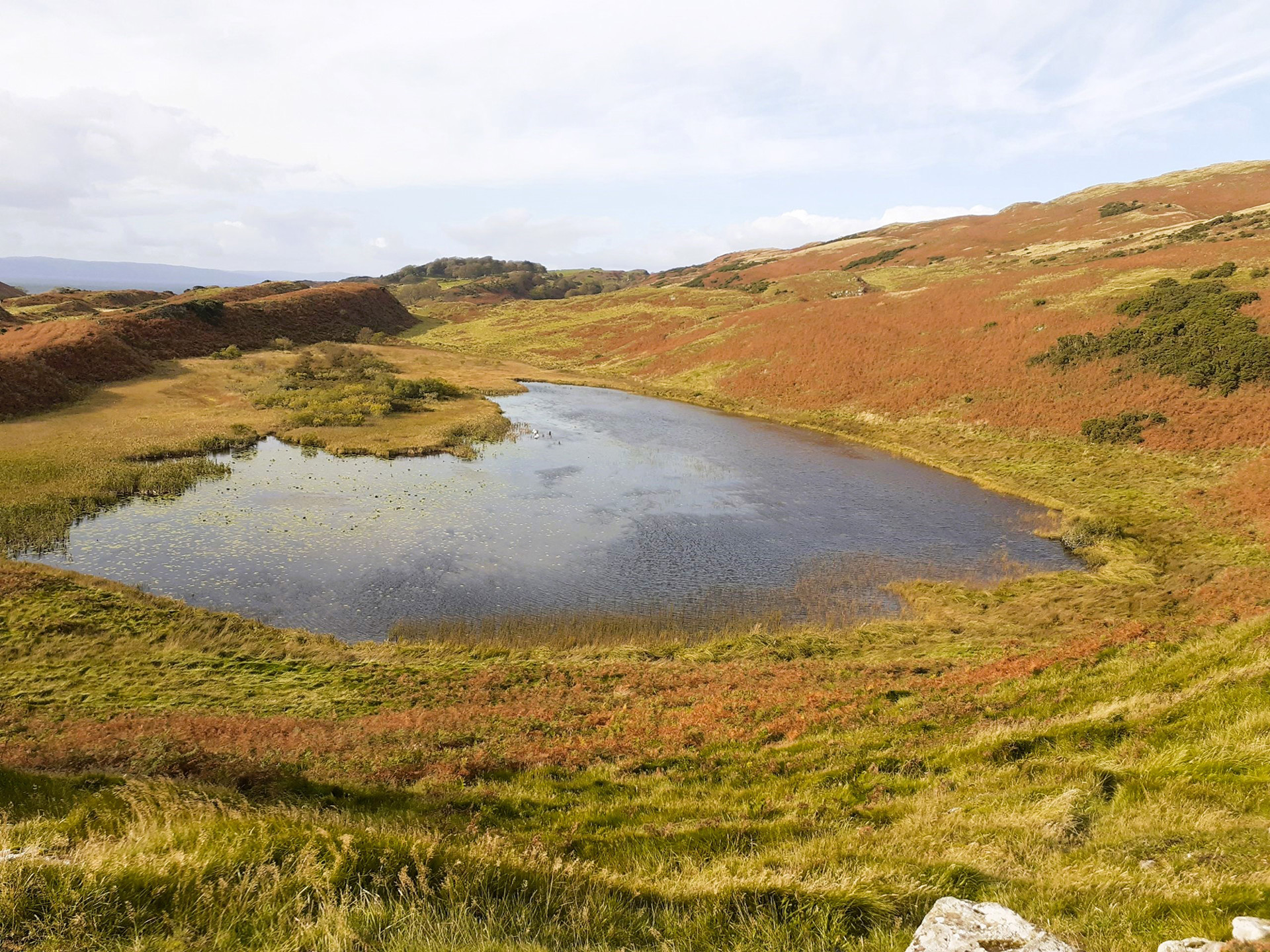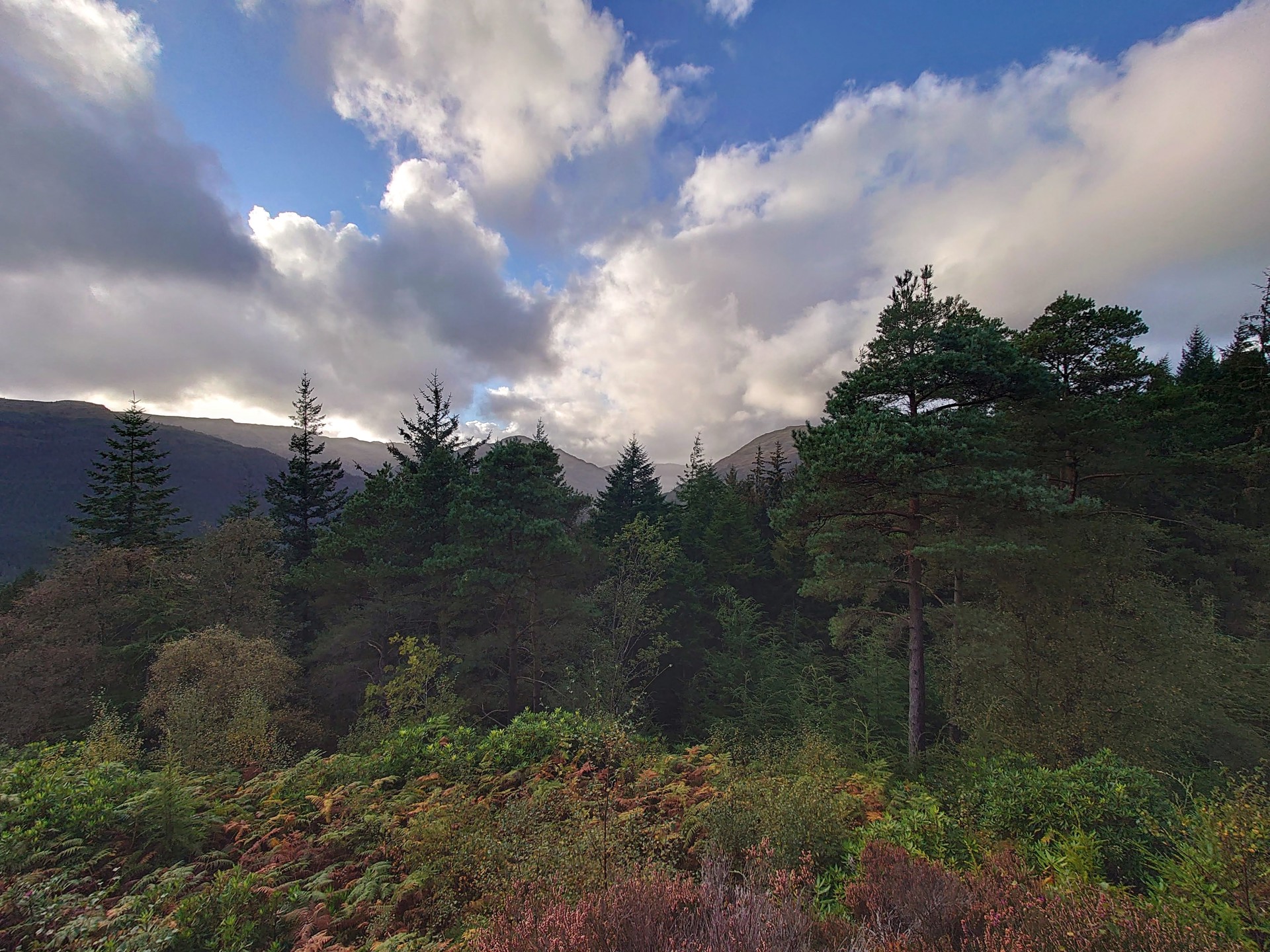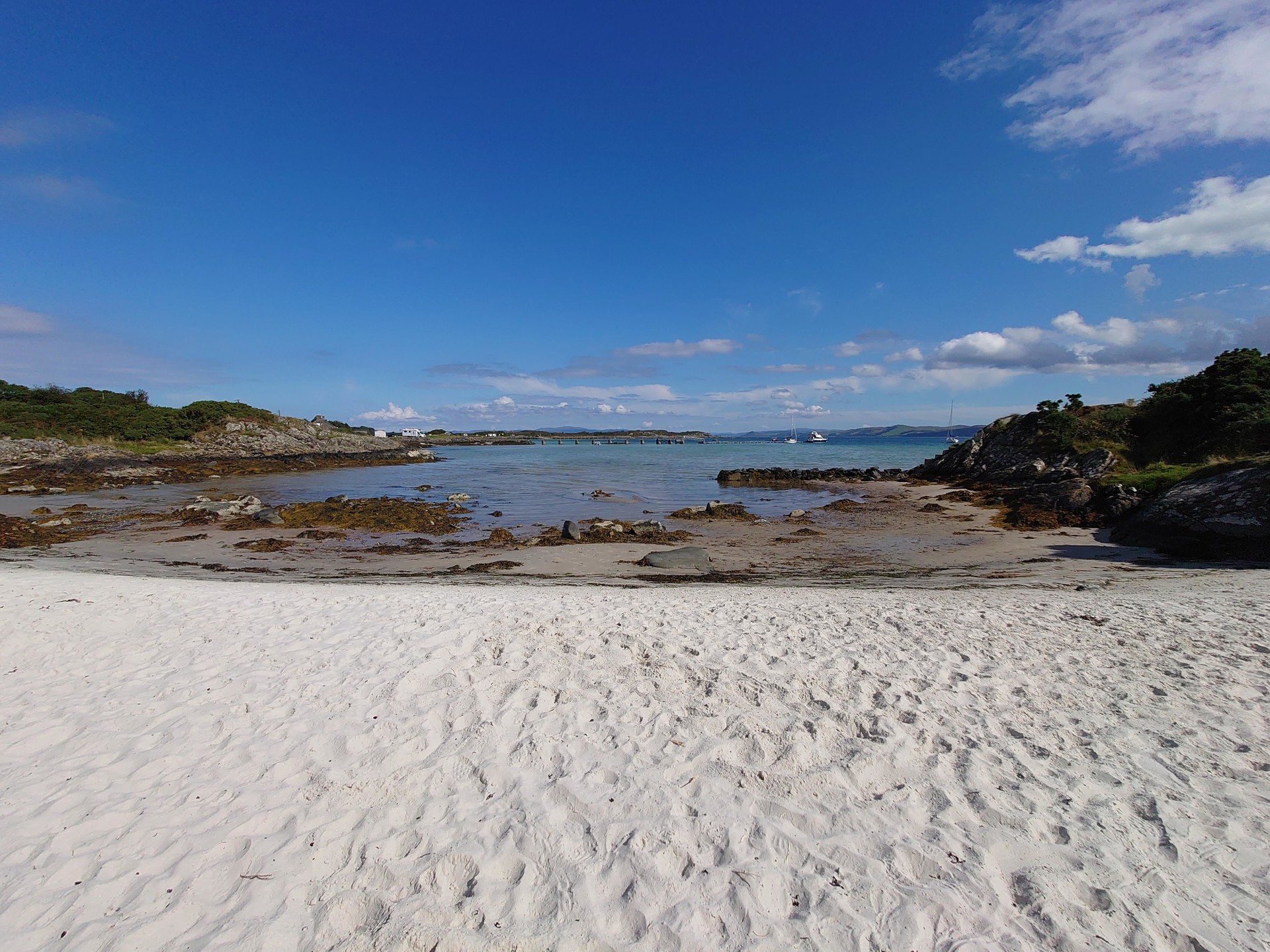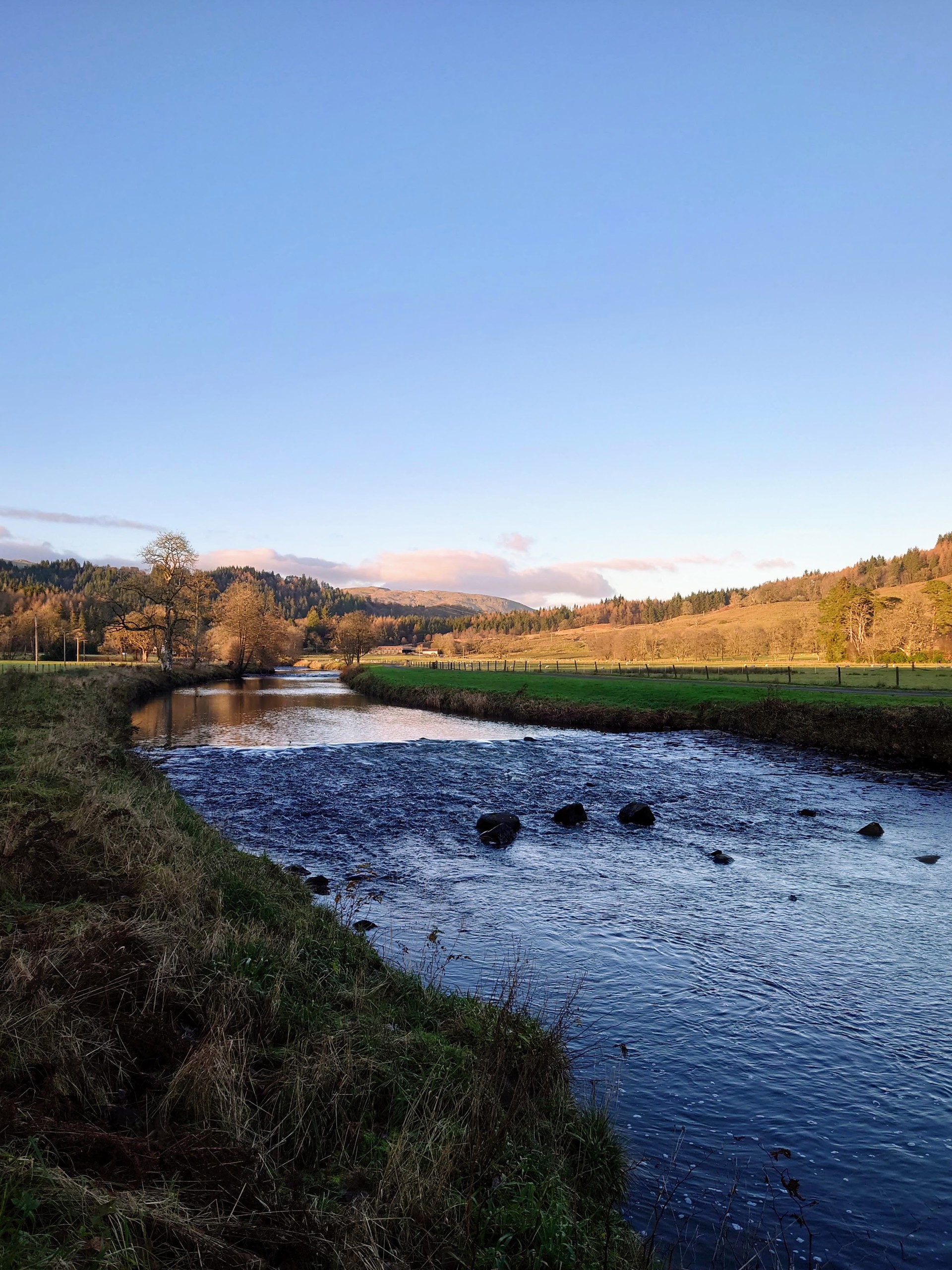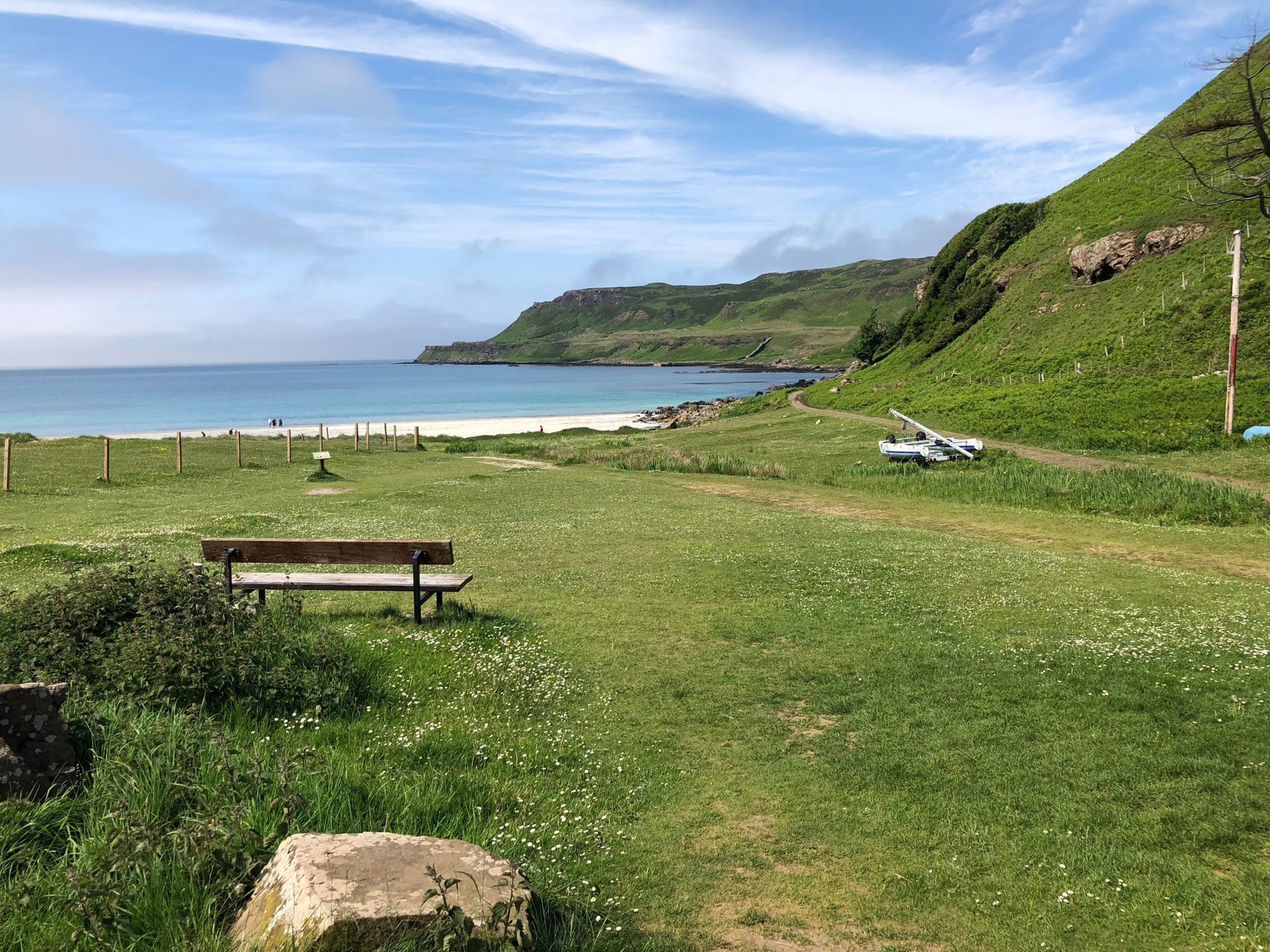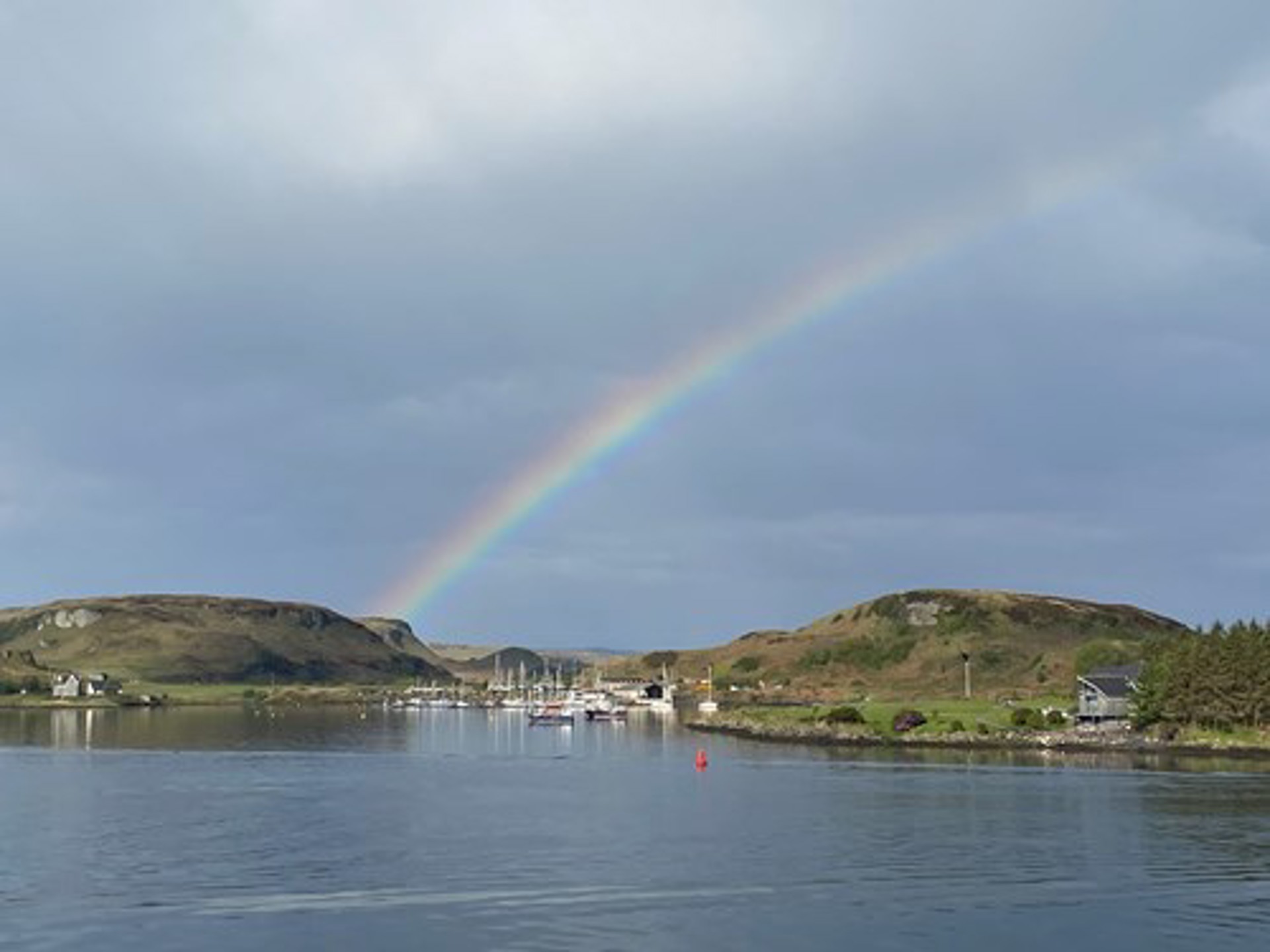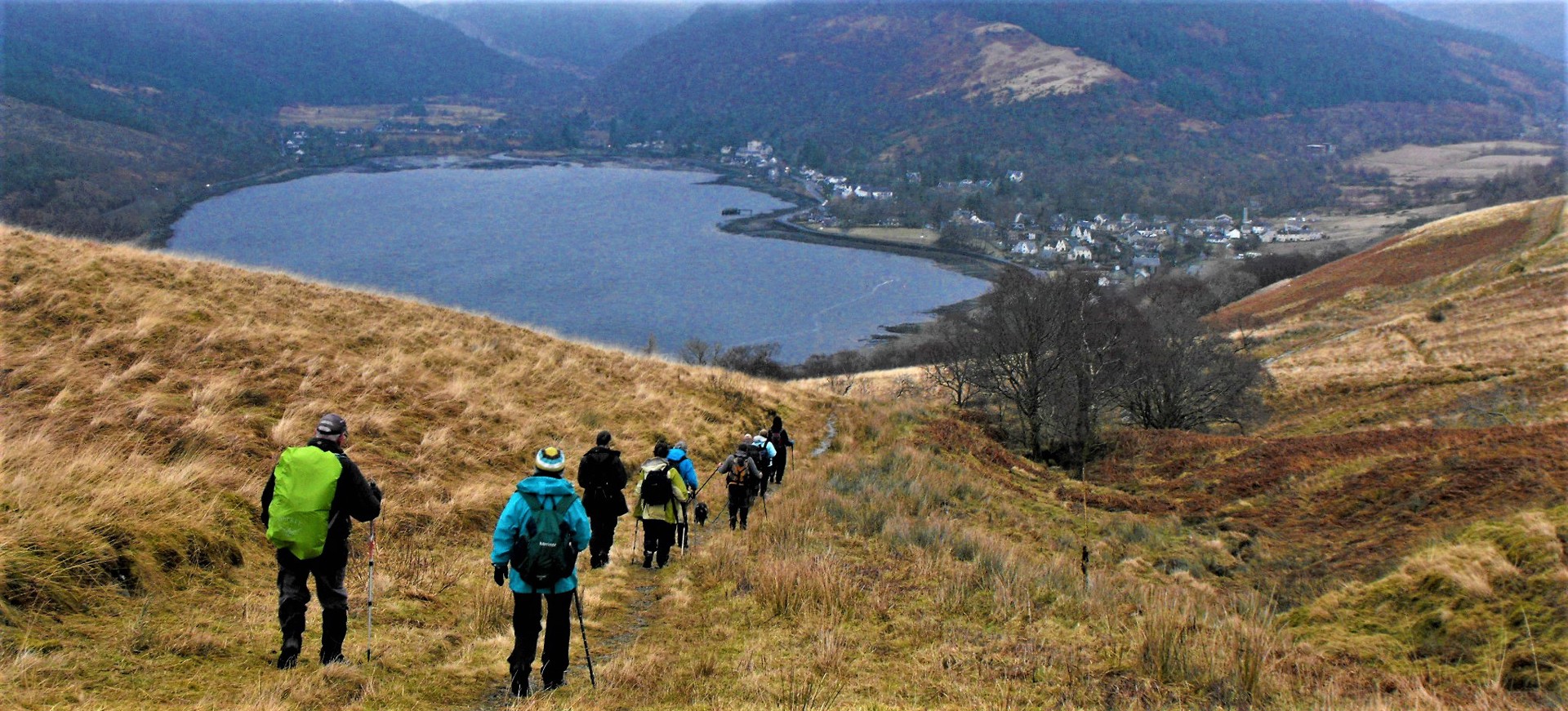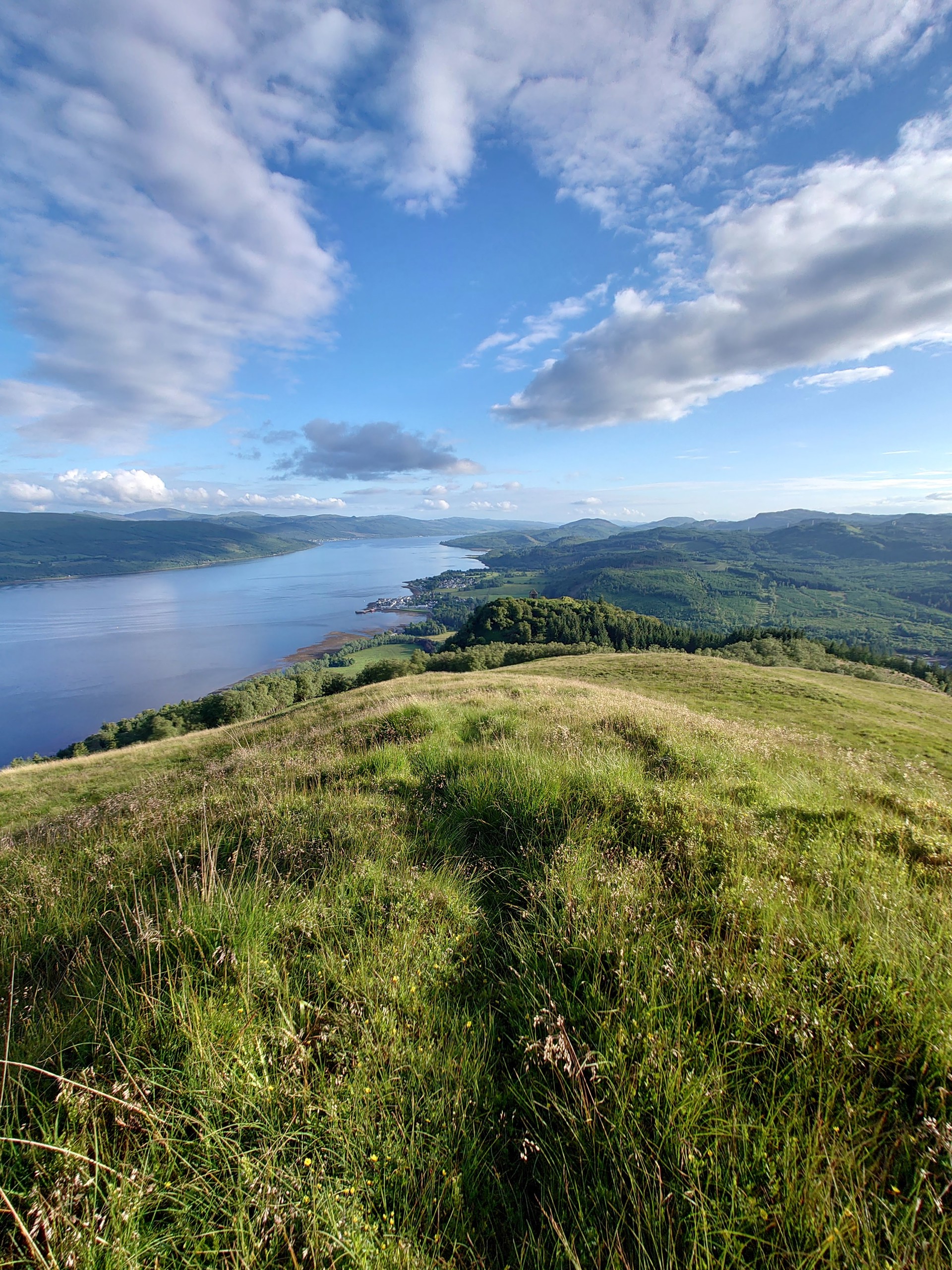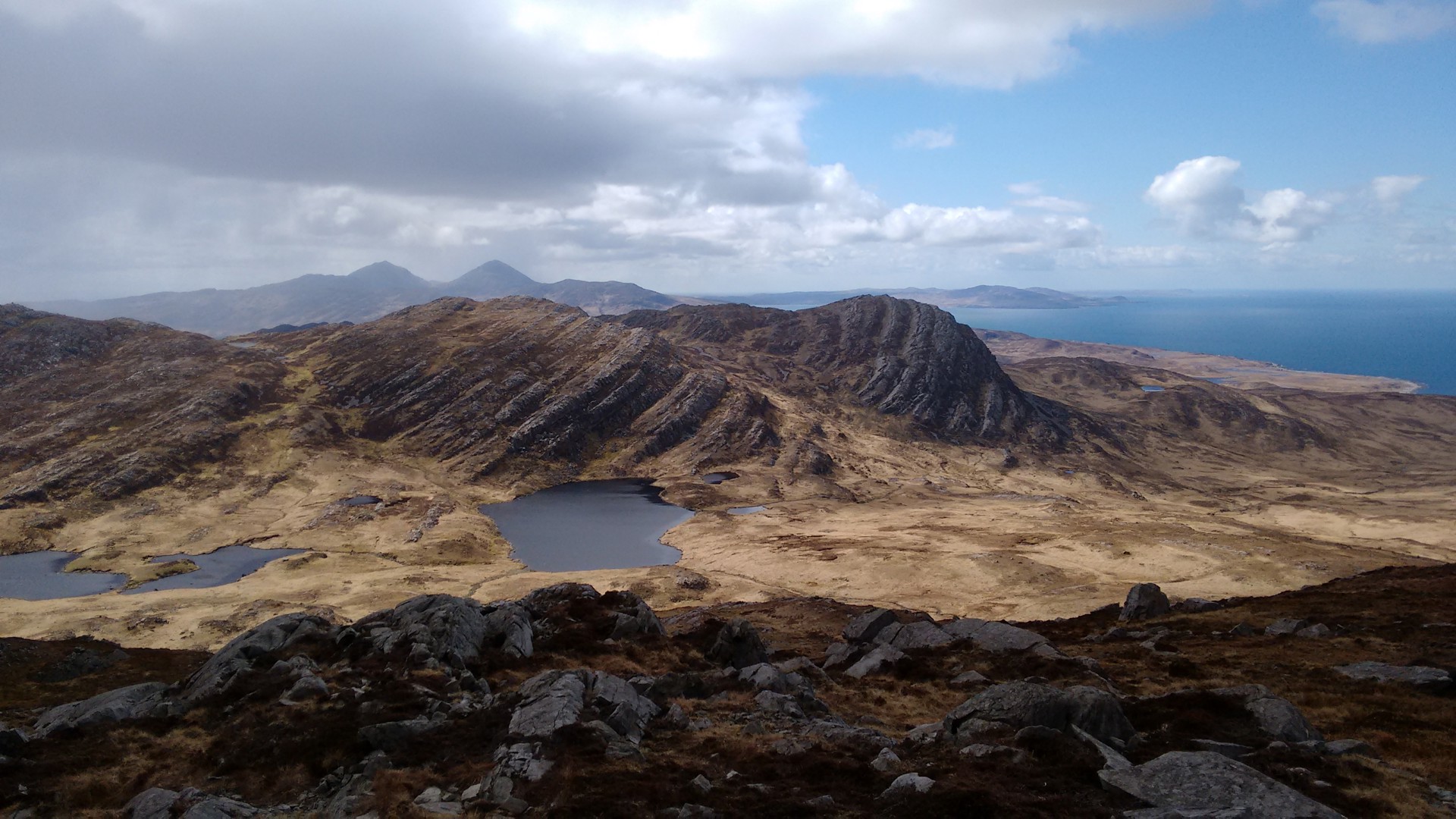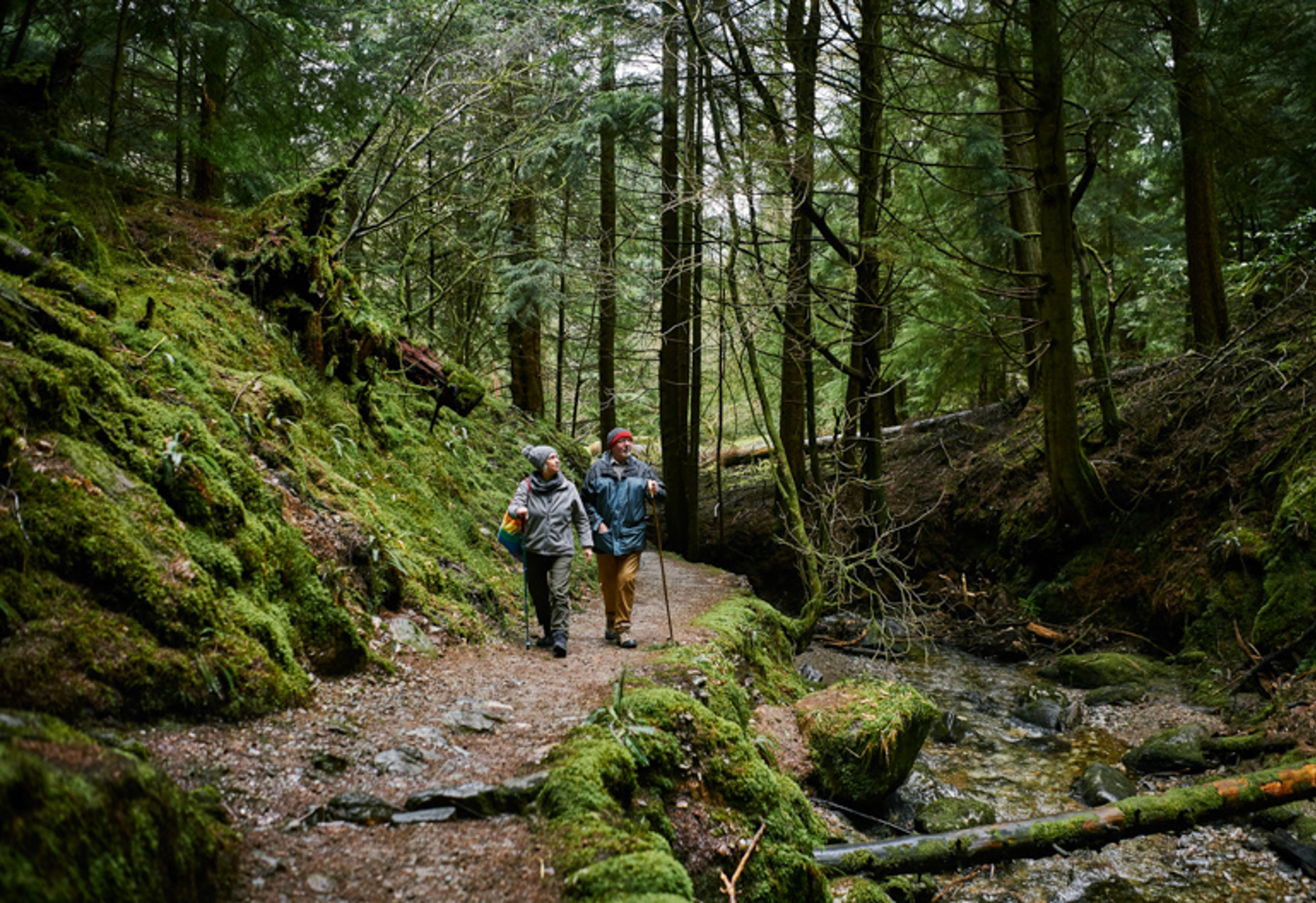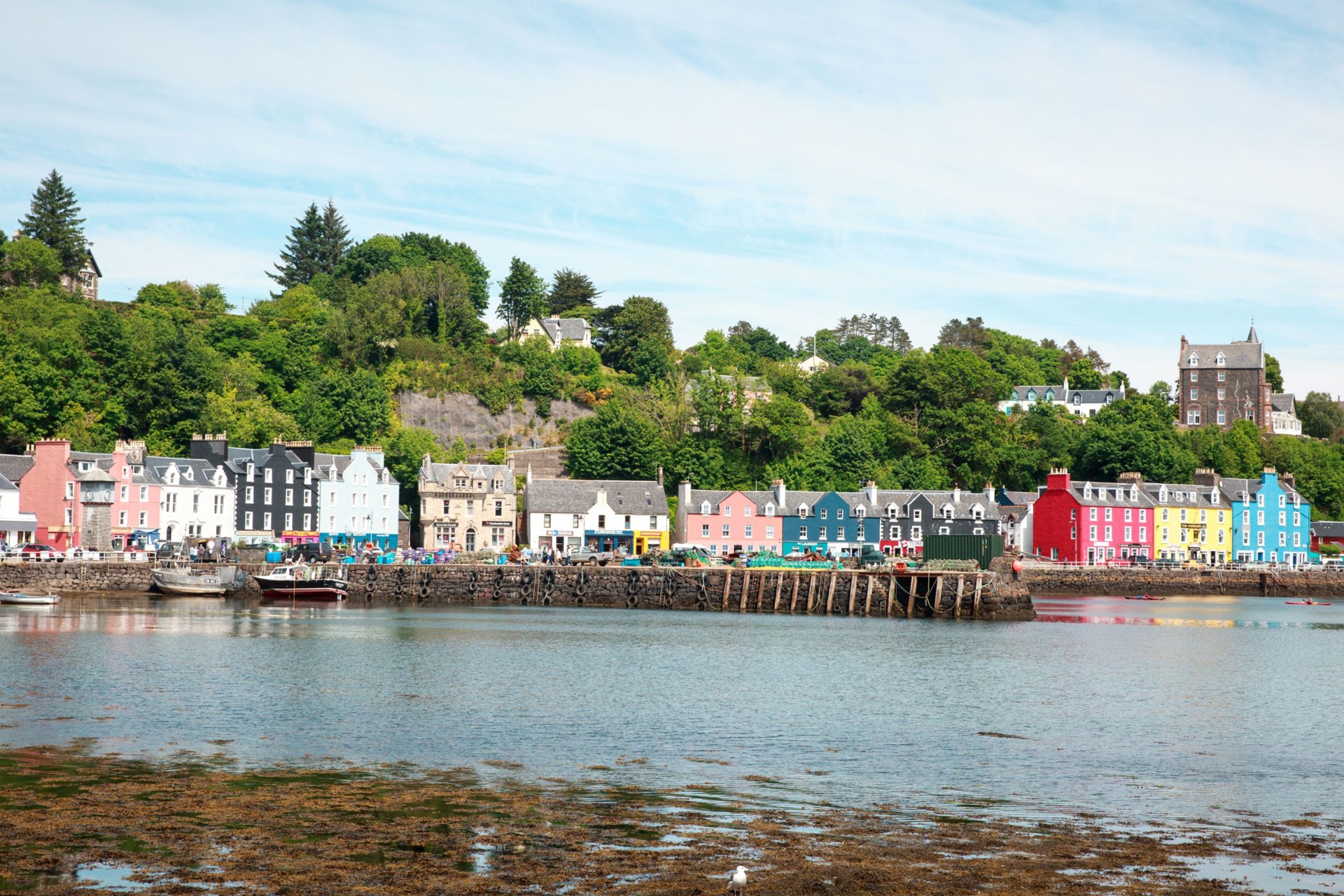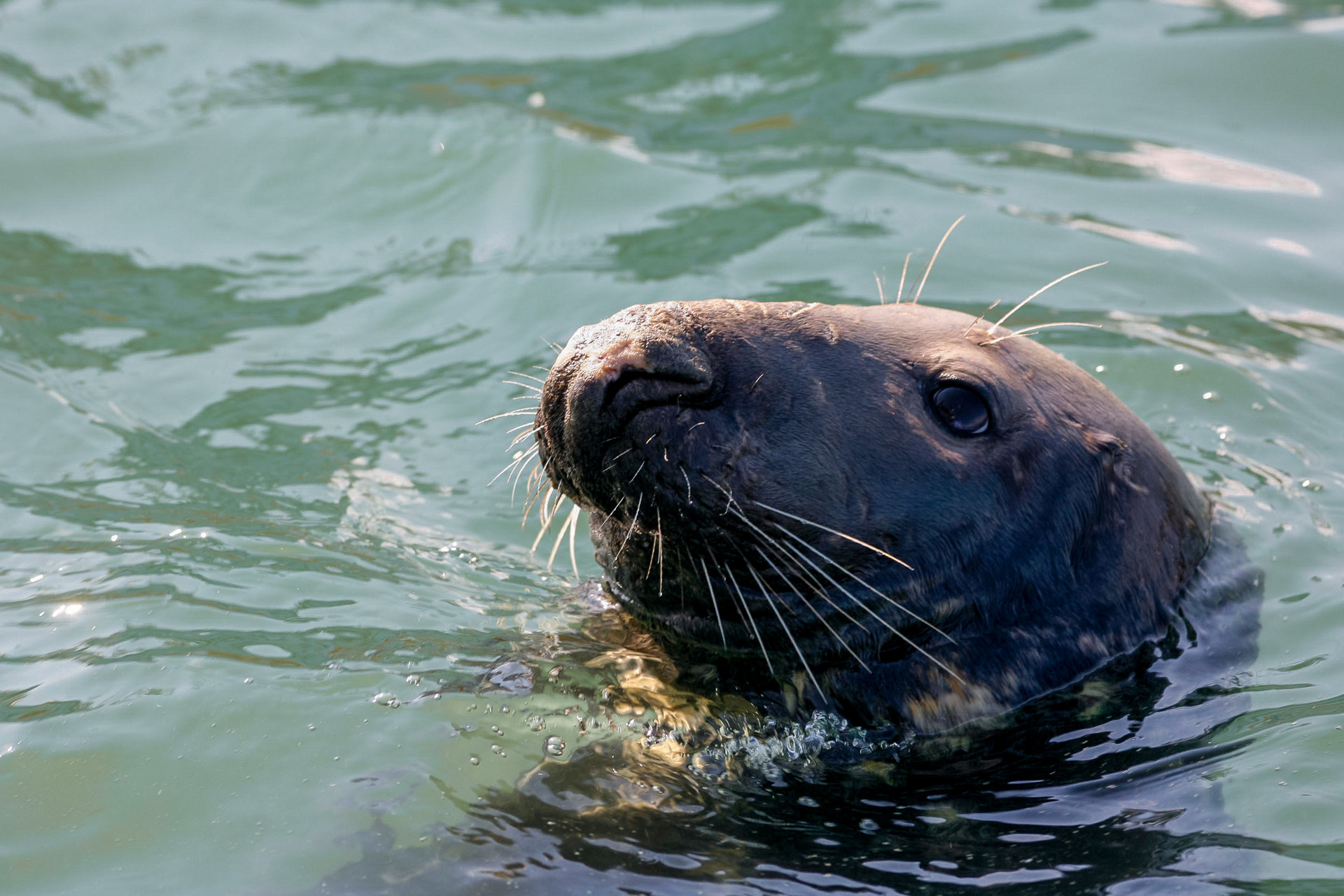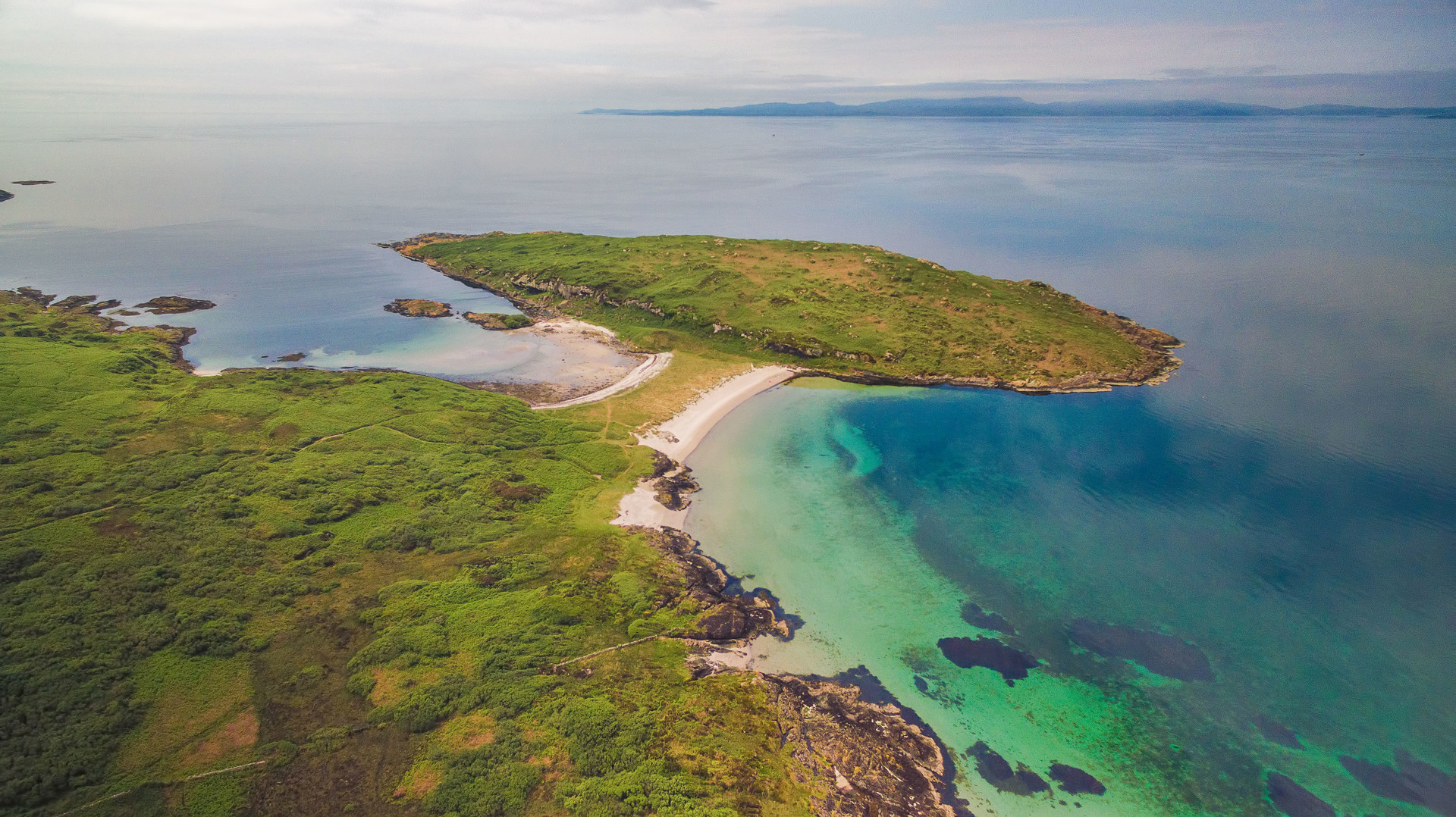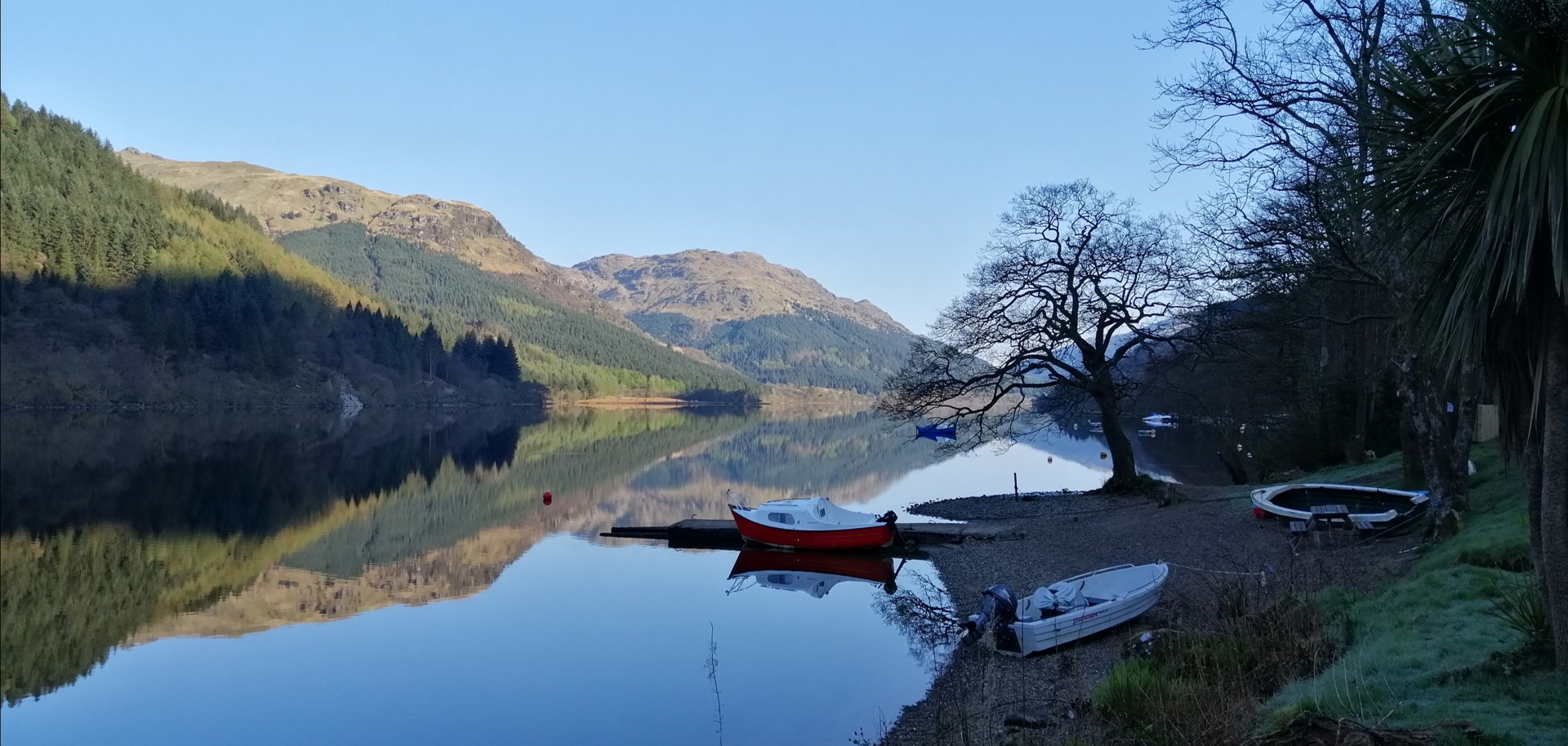
Short Distance Walking Trails in Argyll & the Isles
Scotland's Walking CoastArgyll & the Isles is the perfect place for an endless choice of short walks.
If you want to stretch your legs and enjoy nature alongside stunning views, you can select short walk based on duration or place. With easy to follow trails and signposted routes, you can enjoy a day's excursion or link a few as part of a mini-break adventure.
Why not invite family and friends to join you?
Walking can be the best way to get inspired
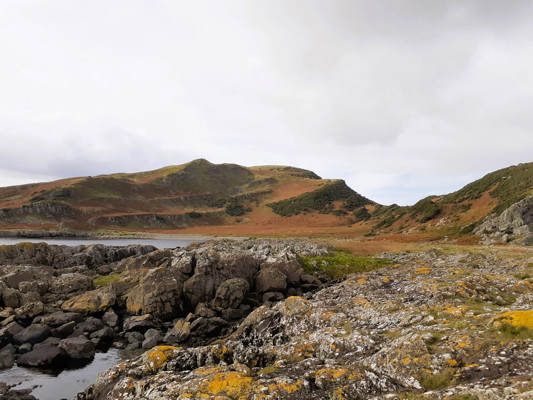
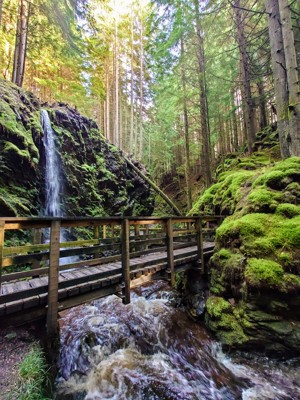
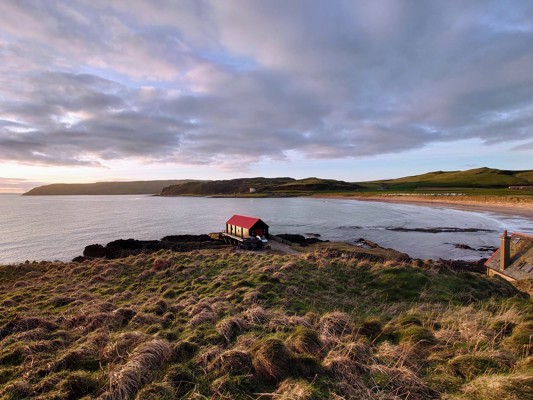
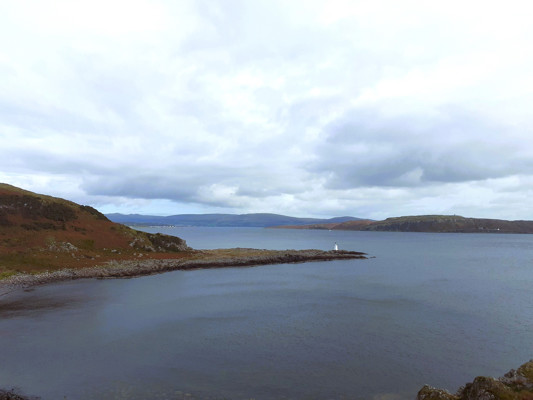
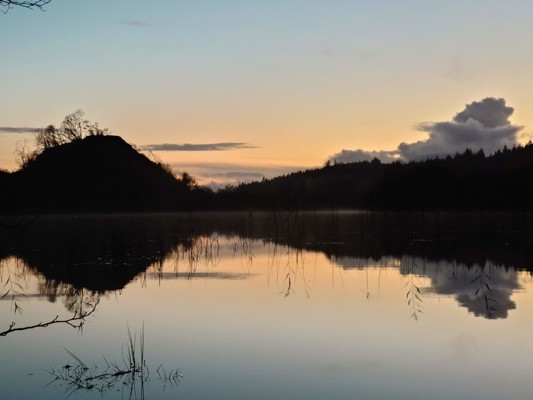
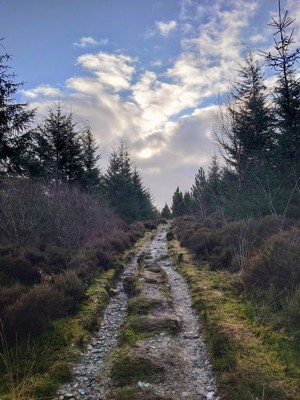
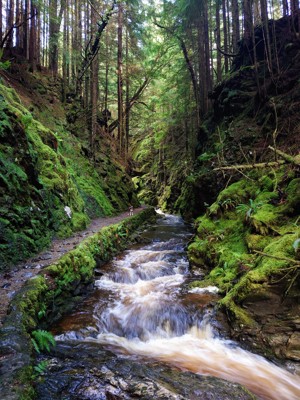
Short Walks on Bute
St Blane's Church
Distance: 1km 2/3miles | Time: 1/2 to 3/4 hourAscent: 50m
Terrain: Easy path and grassy slopes, can be muddy after rain
Access: Not accessible for wheelchairs / buggies
Map: OS Landranger 63 (1:50 000) OS Explorer 362 (1:25 000)
Start: Small car parking area at the south end of Plan Road
Finish: Small car parking area at the south end of Plan Road
Parking: Small car parking are on left just before turning area
Grid Reference: NS 092 531
Public Transport: No, but St Blane’s can also be visited on foot if undertaking the West Island Way (Kilchattan Bay Loop). There are buses to Kilchattan from Rothesay (490). Bike hire is also available in Rothesay.
Toilets: No
Facilities: None
Getting there: St Blane’s Church lies 9 miles south of Rothesay. Take the B881 road south until you meet the A844. Turn left. After 2 miles turn right onto Plan Road, which passes Bute’s tiny airfield. Follow this for 2 miles. A small parking area will be to your left just before the turning circle. You can also go south via the A844 down the east coast. Turn left onto Plan Road after passing through Kingarth.
Further information on road, cycle and walking routes can be found on this map >
Route Description:
To start the walk head south and pass through the metal gate to Plan Farm then immediately left through a wooden gate (signposted). Follow a grassy path between a drystone wall and fence which will lead you up past some trees to the ruins of St Blane’s Church, to your right, and the well, which sits at the foot of a small cliff to your left. Return the same way you came*.
The Church itself is believed to have been built in the 12th Century on the higher ground that forms the upper cemetery. Its Romanesque style – a style which incorporated semi-circular arches and generally predates the Gothic period – includes the later addition of a chancel arch (Historic Environment Scotland).
What is perhaps of more interest is that this site was once that of a 6th Century monastery. Depending on which literature you read it is believed to have been either founded by St Catan or St Blane. The commoner story is that Blane and his mother (St Catan’s sister) were banished when he was born to an unknown father and it was not until he was a man, having been brought up under other monks, that he returned to take over the monastery. Whichever is the case, it is certain Blane did return to Bute and become abbot here before his death in the late 6th Century.
The site continued to be used for religious purposes and burials until the early 18th Century, much of its stone repurposed over the years. It is likely that the monastery fell into disrepair during the Viking raids from the late 8th Century as this is where the list of abbots appears to cease. It would then have been readopted for Christian use around the time the church was built but what happened during the interim is harder to discern. Features to look out for include the thick walls used including the circular enclosure known as ‘The Cauldron’, the knave and chancel of the Church, the lower cemetery which was reserved for the burial of women and remains of what may have been small cells (see Canmore for more details). Artefacts recovered include gold coin, pottery, carvings, ornaments and neolithic agate tools (there is an iron age fort nearby) many of which are either in the National Museum of Scotland or Bute Museum.
*You can also join the Kilchattan Bay Loop at St Blane’s but due to the limited parking and lack of public transport we recommend undertaking the 5 mile loop from Kilchattan.
The described route and accompanying information are there to be used as a guide. Please be aware that track and path closures can happen at any time. All walks are undertaken at your own risk.
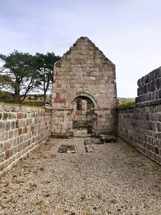
Kilchattan Bay to Rubh’ an Eun Lighthouse
Distance: 4.5km / 2 3/4 miles | Time: 1 1/4 to 2 hoursAscent: 90m
Terrain: The path is generally grassy with areas of bracken. Rocky and uneven areas, particularly close to the shoreline.
Access: This path is not suitable for wheelchairs/buggies.
Map/s: OS Landranger 63 (1:50 000) OS Explorer 362 (1: 25 000)
Start: Road end just before the bus turning area
Finish: Road end just before the bus turning area
Parking: Street parking or small car parking area at the end of the road
Grid Reference: NS 108 545
Public Transport: There are buses to Kilchattan from Rothesay (490). Bike hire is also available in Rothesay.
Toilets: Yes, Kilchattan Bay
Facilities: Kilchattan Bay Post Office and Tearoom
Getting there: From Rothesay either follow the A844 or B881/A844 south to Kingarth. Turn south by Kingarth Hotel onto the B881 to Kilchattan Bay. Follow to the road end where there is a sign board and parking.
Route Description:
The walk takes in the more rugged section of the Kilchattan Bay Loop which is part of the West Island Way. Its views across to Great and Little Cumbrae and down towards Arran make for a lovely coastal walk, with seabirds, wildlife and plenty of boats plying the waters.
The rocky shoreline is of interest as the geology of Bute is most definitely split. Here at the south of the Island you are also south of the Highland Boundary Fault (which splits the Island between Rothesay and Ardscalpsie, with Loch Fad running along its line). Bute Museum describes the geology well but in brief the rocks to the south of the fault are predominantly of the early Devonian period consisting mainly of Old Red Sandstone. However, the tip of the Island which this walk encompasses saw a huge amount of volcanic activity during the early Carboniferous period and this has created a mixture of volcanic dikes, sills and metamorphosed rocks. The latter are where rock is changed through huge temperature fluctuations – particularly where sedimentary rocks and igneous rocks came into contact - and folding. Look out for columnar sandstone along the shore near the beginning of the walk and Creag a’Mhara. (If you are interested in the science behind the columnar sandstone more information can be found here)
The West Island Way is clearly signposted and for the most part the path hugs the shoreline, with the rugged escarpment rising above you on the inland side, trees occasionally breaking the skyline.
After a short distance you will pass the remains of the Old Pump House which was once used to supply water to Kilchattan and Kilgarth. Continuing onwards and through a gate the cliffs of Creag a’ Mhara close in and a rocky shore is reached. The path does become rougher as it heads south towards Hawks Neb (marked Nib on OS Maps), an Old Red Sandstone cliff once named for its shape. Rockfall has changed its birdlike resemblance. Just south of the cliff is the entrance to an old sea cave.
Continue for another half a mile and you will reach the small headland of Rubh’ an Eun and its lighthouse, built in 1911. Its position safeguards the west side of the Firth of Clyde opposite the lighthouse on Little Cumbrae (Little Cumbrae’s third lighthouse). Rubh’ an Eun means headland of the bird, so perhaps this is an opportunity to enjoy the views south to Arran and look out for the wide range of sea birds that may be seen here.
To return go back the same way you came.
The described route and accompanying information are there to be used as a guide. Please be aware that track and path closures can happen at any time. All walks are undertaken at your own risk.
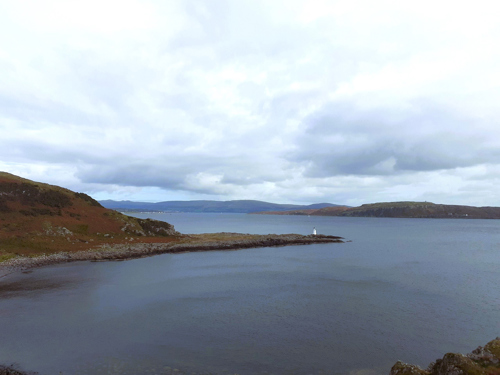
Kilchattan Bay Circular
Distance: 8km / 5 miles | Time: 3 to 4 hoursAscent: 275m
Terrain: Path (sometimes indistinct) and some road. Grass, bracken and rough terrain, rocky near the shore and generally boggier inland.
Access: Not suitable for Wheelchairs/Buggies other than the section from Kilchattan to the road end
Map/s: OS Landranger 63 (1:50 000) OS Explorer 362 (1: 25 000)
Start: Kilchattan Bay
Finish: Kilchattan Bay
Parking: Kilchattan Bay street parking (or at the road end)
Grid Reference: NS 103 549
Public Transport: There are buses to Kilchattan from Rothesay (490). Bike hire is also available in Rothesay.
Toilets: Yes, Kilchattan Bay
Facilities: Kilchattan Bay Post Office and Tearoom
Getting there: From Rothesay either follow the A844 or B881/A844 south to Kingarth. Turn south by Kingarth Hotel onto the B881 to Kilchattan Bay.
Route Description:
The walk takes in the southern section of the West Island Way, the Kilchattan Bay Loop. Its views across to Great and Little Cumbrae and down towards Arran make for a lovely coastal walk, with seabirds, wildlife and plenty of boats plying the waters before it turns inland to Loch na Leighe and St Blane’s Church.
The rocky shoreline is of interest as the geology of Bute is most definitely split. Here at the south of the Island you are also south of the Highland Boundary Fault (which splits the Island between Rothesay and Ardscalpsie, with Loch Fad running along its line). Bute Museum describes the geology well but in brief the rocks to the south of the fault are predominantly of the early Devonian period consisting mainly of Old Red Sandstone. However, the tip of the Island which this walk encompasses saw a huge amount of volcanic activity during the early Carboniferous period and this has created a mixture of volcanic dikes, sills and metamorphosed rocks. The latter are where rock is changed through huge temperature fluctuations – particularly where sedimentary rocks and igneous rocks came into contact - and folding. Look out for columnar sandstone along the shore near the beginning of the walk and Creag a’Mhara. (If you are interested in the science behind the columnar sandstone more information can be found here)
The West Island Way (the first long distance path opened on a Scottish Island) is clearly signposted at the start and for the initial part the path hugs the shoreline, with the rugged escarpment rising above you on the inland side, trees occasionally breaking the skyline.
After a short distance you will pass the remains of the Old Pump House which was once used to supply water to Kilchattan and Kilgarth. Continuing onwards and through a gate the cliffs of Creag a’ Mhara close in and a rocky shore is reached. The path does become rougher as it heads south towards Hawks Neb (marked Nib on OS Maps), an Old Red Sandstone cliff once named for its shape. Rockfall has changed its birdlike resemblance. Just south of the cliff is the entrance to an old sea cave.
Continue for another half a mile and you will reach the small headland of Rubh’ an Eun and its lighthouse, built in 1911. Its position safeguards the west side of the Firth of Clyde opposite the lighthouse on Little Cumbrae (Little Cumbrae’s third lighthouse). Rubh’ an Eun means headland of the bird, so perhaps this is an opportunity to enjoy the views south to Arran and look out for the wide range of sea birds that may be seen here.
The path now skirts past Glencallum Bay before heading up and round Roinn Clùmhach (meaning something like ‘divide of the feathers’). The higher route now leads you over to Loch na Leighe which lies to the right of St Blane’s hill. Continue to the north end of the Loch and look out for the farm track. You follow this briefly before turning right onto a slightly higher path that takes you above the farm beside a wall. Beyond on the higher ground nestling by a small wood lies St Blane’s Church, which is well worth a visit.
The Church itself is believed to have been built in the 12th Century on the higher ground that forms the upper cemetery. Its Romanesque style – a style which incorporated semi-circular arches and generally predates the Gothic period – includes the later addition of a chancel arch (Historic Environment Scotland).
What is perhaps of more interest is that this site was once that of a 6th Century monastery. Depending on which literature you read it is believed to have been either founded by St Catan or St Blane. The commoner story is that Blane and his mother (St Catan’s sister) were banished
Walking Routes: Kilchattan and St Blane’s (iii) cont.
when he was born to an unknown father and it was not until he was a man, having been brought up under other monks, that he returned to take over the monastery. Whichever is the case, it is certain Blane did return to Bute and become abbot here before his death in the late 6th Century.
The site continued to be used for religious purposes and burials until the early 18th Century, much of its stone repurposed over the years. It is likely that the monastery fell into disrepair during the Viking raids from the late 8th Century as this is where the list of abbots appears to cease. It would then have been readopted for Christian use around the time the church was built but what happened during the interim is harder to discern. Features to look out for include the thick walls used including the circular enclosure known as ‘The Cauldron’, the knave and chancel of the Church, the lower cemetery which was reserved for the burial of women and remains of what may have been small cells (see Canmore for more details). Artefacts recovered include gold coin, pottery, carvings, ornaments and neolithic agate tools (there is an iron age fort nearby) many of which are either in the National Museum of Scotland or Bute Museum.
Beyond the Church the route continues north joining a farm track. Here the terrain is rugged, with hilly escarpments dropping off to the east. Passing the ruins of the farmstead Kingaven the track goes through the wall. Beyond the path descends right (northeast) across the fields, crossing a bridge and veering towards the small hill of Suidhe Chatain/St Catan (a short climb offers a good view) and faint remains of the old settlement of Branser. Beyond to the north is a mast.
Continuing past the hill you will reach a wall with scattered woodland beyond. You can follow the main path by the wall and drop down through the edge of the woods to their bottom corner before turning right through the houses into Kilchattan OR after following the path along the wall a short distance veer off right on a faint path down to the houses a little further south near the jetty.
If you are seeking refreshments Kilchattan Post office is just to the north of where the main path comes out.
The described route and accompanying information are there to be used as a guide. Please be aware that track and path closures can happen at any time. All walks are undertaken at your own risk.
Short Walks in Dunoon & Cowal
Black Gates & Puck's Glen
Distance: 5km / 3miles | Time: 2 to 2 1/2 hoursAscent: 190m
Terrain: A mixture of easy tracks and steep narrow paths with steps. The path up Puck’s Glen and the descent can be slippery when wet.
Access: The track from Benmore car park to the entrance of Puck’s Glen (2.7km return) is wheelchair friendly but thereafter the path is too narrow and steep for wheeled access. There is a main road crossing.
Map/s: OS Landranger 56 (1:50 000) OS Explorer 37 (1: 25 000)
Start: Benmore car park
Finish: Benmore car park
Parking: Benmore car park
Grid Reference: NS 143 854
Public Transport: Bus 484, 486
Toilets: Seasonal
Facilities: Benmore Botanic Gardens and the café, Redwood Coffee, at the entrance are well worth a visit (open March to October). Historic Kilmun heritage centre is 4 miles south on the A880 and the Shore Café can be found just a little further towards Strone point. Going towards Dunoon there is the Holy Loch Coffee Shop at the Marina, which is normally open all year.
Getting there: Benmore Botanic Gardens can be found 6 miles north of Hunters Quay ferry terminal (Dunoon) on the left-hand side of the A815. From Strachur follow the A815 south for 11 miles. The car park can be found on your right a mile after passing Loch Eck.
Route Description
Argyll’s mild and damp climate and mixture of hills, fjord like lochs and glens have long been a favourite for estate owners wishing to plant superb specimens of redwoods, firs, cedars, and many Himalayan species, including Azalea and Rhododendron. It is therefore no surprise that this part of Cowal is part of the Argyll Forest Park. Established in 1935, it was the first of its kind in Britain and stretches from the Arrochar Alps to Holy Loch, an inlet off the Firth of Clyde just north of Dunoon.
Benmore Forest and the superb Benmore Botanic Gardens lie within it. Many of the now giant trees, some 150’ tall, were planted in the mid to late 19th Century by successive landowners, including James Duncan and the Younger family. Much of the forest was later gifted to the Forestry Commission. The land for the gardens was then acquired by the Royal Botanic Garden of Edinburgh; they had been searching for a site suited to an impressive collection of seeds and plants, that required the damp, mild climate well known in this part of Argyll.
Within this forest there are many hidden gorges and waterfalls with mossy rocks and pockets of ferns that inspire thoughts of magical folk hiding in its rich green folds. This walk includes the delightful Puck’s Glen, a place of magic indeed.
To start the walk, leave the car park and cross the main road. A path, opposite the Black Gates entrance to the gardens, leads you behind the bus stop to an information board. Turning right you will find yourself on an easy track below the giant trees which loom above to your left. With twisted trunks and giant girths, they are quite a spectacle.
The track ambles easily down Strath Eachaig, the higher hills of Bheinn Mhòr and Sgorach Mòr lying to the west. After a little while you will come to a path on your left, well signposted, that takes you up into Puck’s Glen.
This is where the bubbling burn of Eas Mor (which means big waterfall) tumbles down the magical Puck’s Glen. The narrow path leads you on, sometimes steeply, sometimes along less tumultuous waters, passing over sedimentary rocks that have been folded and metamorphosed to create schists and quartzites, now richly carpeted in lichens, liverworts, mosses and ferns. Walkways and bridges meander ever upwards, crisscrossing waterfalls and winding under steep rockfaces, a surprise awaiting around every corner. When there has been heavy rain the waterfalls are superb but do take extra care in wet conditions.
When you reach a fork drop back towards the burn near a confluence and the path will meander back and forth over the burn once more before bringing you out on to a forestry road above. Here you may wish to take a moment as your ascent is now done. Taking the road left it is now easy walking with glimpses over to the hills on the other side. A small viewpoint affords a better stance although many of the trees below are now quite tall; the view will have changed a lot in the last 100 years!
The walk along the forestry road has a couple of descents routes on the left leading back to the bottom track and car park. You can use the forestry trails with the blue or blue/orange marker posts on your left or continue to a small path that tracks back sharply to your left just before a burn (the green route on our map). It has a small signpost indicating the steep route down that meets the track near the bus stop opposite the car park.
The described route and accompanying information are there to be used as a guide. Please be aware that track and path closures can happen at any time. All walks are undertaken at your own risk.
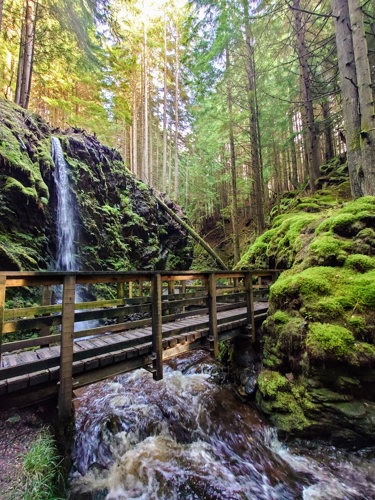
Kilbride Hill Trail
Distance: 4.4km/2¾ miles| Time: 1½ to 2 hoursAscent: 230m
Terrain: Mixture of forestry tracks and paths with some steep uneven sections. Can be muddy in places.
Map/s: OS Landranger 63 (1:50 000) OS Explorer 37 (1: 25 000)
Start: Corlarach carpark
Finish: Corlarach carpark
Parking: Corlarach carpark
Grid Reference: NS 161 765
Public Transport: Buses to Dunoon include the 478, 480, 484, 486 & 489.
Ferry to Hunter’s Quay (Western Ferries - passenger and vehicle) and Dunoon (Calmac - passenger)
Toilets: Public toilets can be fund by Glen Morag carpark, Moir Street and at Sandbank. Otherwise in hotels, cafés, restaurants, etc as a paying customer.
Facilities: There are plenty of places to shop, eat and drink in the Dunoon area between Holy Loch and West Bay, many of which can be found on the seafront.
Getting there: From the east and the south including Glasgow it easiest to catch the ferry to Dunoon. From the north or west via the A815 (and/or A885).
Route Description
This pleasant walk is a good leg stretcher taking in fine views over Dunoon and the Firth of Clyde via forest paths and tracks. You can start from the forestry carpark at Corlarach, near the reservoir in Bishop’s Glen. And it is easy enough to extend the walk to take in the reservoir or even walk up from Dunoon itself if you wish to make a day of it.
From the carpark head west on the track up the glen leaving the sea behind you. After a bend in the track over a small burn (stream), ignore a path off to the right leading down to the reservoir and continue for 200m until you reach a wooden signpost marked with cycle tracks. Just behind the sign a path leads up the hill on the left bank of a burn, with a red and blue marker post. Effectively you will be following the blue markers – the newly routed Kilbride Hill Trail.
A steep pull takes you up through conifers with heathery banks either side. After a short distance the trees thin out and you enter a small area of open moorland. This affords good views back over the Firth which steadily open out as you gain height – bear in mind you will return down this section so you can always enjoy the views on the way back too. Keep an eye out for buzzard and deer, which are often not so far away.
When you reach the forestry track above turn left. This section has a picnic bench handily placed for those wanting to enjoy the vista; it is a good rest point before turning right on the path above the bench to continue up the hill.
Below, Dunoon’s small knoll, where once the castle stood, can be clearly seen at the northeast end of West Bay. Directly below, Bishop’s Glen and the reservoir hide amongst the trees. Dunoon has had connections with the Bishops of Argyll since King James II granted the Bishop of Argyll the Church and lands in the 15th Century (cowalkirk.org.uk). It is most likely to have been an episcopal seat in the 17th Century with a Bishop’s Palace, although there are no longer remains of this. Three stones believed to cover the graves of Bishops have also been found (Canmore ID 699981). Looking to the northwest, the higher hill at the back of the Glen is aptly called Bishop’s Seat and has a trig point at its summit.
Continuing up the path from the track the path now heads back into the trees zigzagging upwards before following the burn. This section rises some 120m over nearly a kilometre, opening out as you gain the higher reaches. The main path turns right as it nears its highest point, contouring across the hillside with long distance views. Take care to keep on the main path with the blue markers (you will also see a faint path continuing up by the burn – the route up to Bealach Gaothach (Windy Pass) and the rough bounds of Kilbride Hill).
After just 300m the path turns right and back down the hill. Steep in places it weaves down through the forest to the track below. Now you just need to turn right, follow the track for 200m then return down your ascent path. Remember to turn right back along the track at the bottom to reach the carpark. (If you wish to add on the reservoir circuit you can take the small path down to your left halfway back to the car park you passed earlier).
The described route and accompanying information are there to be used as a guide. Please be aware that track and path closures can happen at any time. All walks are undertaken at your own risk.
Berry Burn Trail
Distance: 3.4km/≈2miles | Time: 1 to 1½ hoursAscent: 130m
Terrain: Mixture of forestry tracks and paths with some steep uneven sections. Can be muddy in places.
Access: Not suitable for wheelchairs or buggies
Map/s: OS Landranger 63 (1:50 000) OS Explorer 37 (1: 25 000)
Start: Corlarach carpark
Finish: Corlarach carpark
Parking: Corlarach carpark
Grid Reference: NS 161 765
Public Transport: Buses to Dunoon include the 478, 480, 484, 486 & 489.
Ferry to Hunter’s Quay (Western Ferries - passenger and vehicle) and Dunoon (Calmac - passenger)
Toilets: Public toilets can be fund by Glen Morag carpark, Moir Street and at Sandbank. Otherwise in hotels, cafés, restaurants, etc as a paying customer.
Facilities: There are plenty of places to shop, eat and drink in the Dunoon area between Holy Loch and West Bay, many of which can be found on the seafront.
Getting there: From the east and the south including Glasgow it easiest to catch the ferry to Dunoon. From the north or west via the A815 (and/or A885).
Route Description
Just behind the sign a path leads up the hill on the left bank of a burn, with a red and blue marker post. Effectively you will be following the red markers for the Berry Burn Trail.
A steep pull takes you up through conifers with heathery banks either side. After a short distance the trees thin out and you enter a small area of open moorland. This affords good views back over the Firth which steadily open out as you gain height – bear in mind you will return down this section so you can always enjoy the views on the way back too. Keep an eye out for buzzard and deer, which are often not so far away.
When you reach the forestry track above turn left. This section has a picnic bench handily placed for those wanting to enjoy the vista. Below, Dunoon’s small knoll, where once the castle stood, can be clearly seen at the northeast end of West Bay. Directly below, Bishop’s Glen and the reservoir hide amongst the trees. Dunoon has had connections with the Bishops of Argyll since King James II granted the Bishop of Argyll the Church and lands in the 15th Century (cowalkirk.org.uk). It is most likely to have been an episcopal seat in the 17th Century with a Bishop’s Palace, although there are no longer remains of this. Three stones believed to cover the graves of Bishops have also been found (Canmore ID 699981). Looking to the northwest, the higher hill at the back of the Glen is aptly called Bishop’s Seat and has a trig point at its summit.
Continue along the track from the picnic bench for 250m to a corner in the track and you will see a path leading left next to a cycle route sign. Take this and you will find yourself meandering back down next to the Berry Burn, which lies off in the trees to your right. It is uneven and a little steep in places but clear enough to follow. The Sitka and conifer plantations offer good cover for small birds such as siskin and coal tits, offering them food and refuge from birds of prey.
The path eventually veers left and takes you slightly back up for the next 10-15 mins until it meets your initial path up the hill on the more open moorland. Turn right and return down your ascent path. Remember to turn right back along the track at the bottom to reach the carpark.
If you wish to add on the reservoir circuit you can take the small path down to your left halfway back to the carpark, which you passed earlier.
The described route and accompanying information are there to be used as a guide. Please be aware that track and path closures can happen at any time. All walks are undertaken at your own risk.
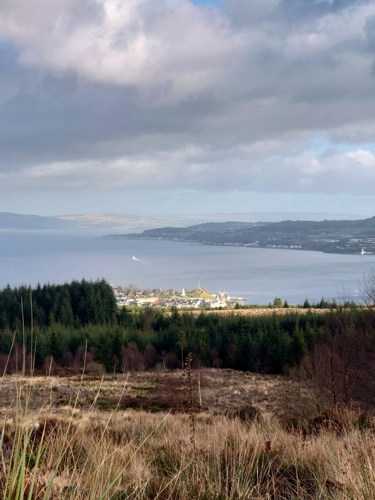
Bishop’s Glen & Reservoir Walk
Distance: 2.6km/1½ miles | Time: ¾ to 1¼ hoursAscent: 70m
Terrain: Mixture of forestry tracks and paths with narrow uneven sections. Can be muddy in places.
Access: Not suitable for wheelchairs or buggies except on the main forestry tracks. Alternative parking (limited) can be found on the north side of the reservoir which can be accessed from Nelson Street for users that just want to visit the reservoir area.
Map/s: OS Landranger 63 (1:50 000) OS Explorer 37 (1: 25 000)
Start: Corlarach carpark
Finish: Corlarach carpark
Parking: Corlarach carpark
Grid Reference: NS 161 765
Public Transport: Buses to Dunoon include the 478, 480, 484, 486 & 489
Ferry to Hunter’s Quay (Western Ferries - passenger and vehicle) and Dunoon (Calmac - passenger)
Toilets: Public toilets can be fund by Glen Morag carpark, Moir Street and at Sandbank. Otherwise in hotels, cafés, restaurants, etc as a paying customer.
Facilities: There are plenty of places to shop, eat and drink in the Dunoon area between Holy Loch and West Bay, many of which can be found on the seafront.
Getting there: From the east and the south including Glasgow it easiest to catch the ferry to Dunoon. From the north or west via the A815 (and/or A885).
Route Description
A delightful walk in Bishop’s Glen taking in mixed woodlands, open vistas over the reservoir, and the Balgaidh Burn. There are plenty of spots to take in the woodland and enjoy views over the reservoir where you are likely to see a range of birds including common eider, heron and even the occasional cormorant. You can start from the forestry carpark at Corlarach or even walk up from Dunoon if you wish to make a day of it.
From the carpark head west on the track up the glen leaving the sea behind you. After a bend in the track over a small burn (stream), take the path off to the right leading down to the reservoir. Turn left and it is now a pleasant meander west near the reservoir shores, where you can drop down at its western end for better views before continuing along the path on the south side of the Balgaidh Burn (possibly meaning stream of the fox).
As you leave the reservoir behind you will pass the first bridge down to your right and, unless you wish to cross for a shorter circuit, continue into the trees and up the Bishop’s Glen. Keeping the forestry track to your left you will cross a couple of minor burns and a small footbridge, another path leading off to your right down to the Balgaidh Burn before coming to the turn right down to the bridge which you need to take to return down the north side (if you reach the forestry track you have gone too far!).
There is a bit of a walkway, and the path offers glimpses down to the burn far below. As you approach the reservoir the woodland opens out and you can either keep to the path nearest the burn or on the paths slightly to the left that run parallel – just avoid taking any paths up to the forestry track above unless you want to take the longer walk indicated below*.
As you approach the reservoir there are several nice spots to sit and enjoy the woodland or you can drop down to the water’s edge for more open views. The name Bishop’s Glen reflects the areas importance where Dunoon had connections with the Bishops of Argyll. King James II granted the Bishop of Argyll the Church and lands in the 15th Century (cowalkirk.org.uk) and it is most likely to have been an episcopal seat in the 17th Century with a Bishop’s Palace, although there are no longer remains of this. Three stones believed to cover the graves of Bishops have also been found (Canmore ID 699981). At the head of the glen the hill aptly named Bishop’s Seat overlooks the reservoir.
Continue along the side of the reservoir to its eastern end where there are some good picnic spots before dropping to the path under the reservoir and crossing its outflow. Bear right and continue up the path until you reach the path that brought you down from the forestry track on your left. Turn left up the path then left onto the track back to the carpark.
*If you wish to extend the route to a 5km circuit, you can continue west up the Bishop’s Glen until you meet the forestry track (a couple of paths lead you onto it). Turn right onto this and continue for a kilometre to a great viewpoint on your right overlooking Dunoon. Just after this you join a major track which you can follow for 250m before a fork. Turn right and head back down the hill to Alexander Street. Turn right and continue for 400m. You will pass Mary Street and then need to turn right onto Nelson Street, this will take you back up to the hill to the reservoir. Turn left and continue across the outflow and round the south side of the reservoir until you meet your outward path to take you back to the carpark. The extension is marked in white on the map and can also be found here.
The described route and accompanying information are there to be used as a guide. Please be aware that track and path closures can happen at any time. All walks are undertaken at your own risk.
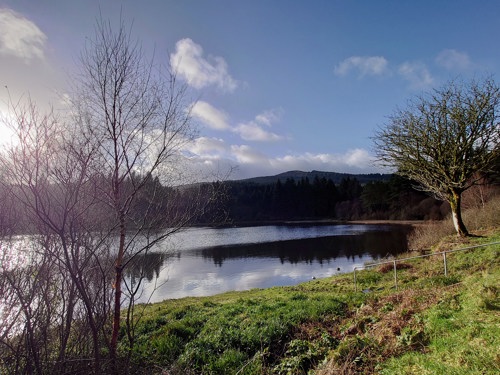
Short Walks in Kintyre & Gigha
Dunaverty and Keil
Distance: 5.6 to 6.7km (3½ to 4 miles) | Time: 2 to 3 hoursAscent: 50 -110m
Terrain: Easy paths, roads, tracks or beach for the most part.
The outlying Dunaverty Rock itself has a very narrow, steep and precipitous path and is surrounded by sheer sea cliffs; this can easily be omitted.
Access: There is wheelchair access along the road and track leading through the Golf Course but not up to the caves, footprints or on to the headland. There are tracks leading onto the beaches but access is not straight forward and the sand can be quite soft.
Map/s: OS Landranger 68 (1:50 000) OS Explorer 356 (1: 25 000)
Start: Carpark by Keil Caves
Finish: Carpark by Keil Caves
Parking: Carpark by Keil Caves (further parking at west end of Dunaverty Bay by Public Toilets)
Grid Reference: NR 670 077
Public Transport: Bus 444 (limited service at weekends)
Toilets: At the west end of Dunaverty Bay
Facilities: Muneroy Tearoom and Shop offers a range of meals and cake. The nearby Argyll Arms Hotel offers accommodation and meals and down by the beach is Machribeg Caravan Park.
Getting there: From Campbeltown take the B842 south to Southend and Kiel, it is just over 10 miles to Kiel Caves carpark. You can also take the minor coast road past Davaar Island on the east side of Kintyre which is very scenic but noticeably slower.
Route Description:
South Kintyre is a place where you really do feel as though you are at the end of one world looking across to another. With breath-taking views, Kintyre’s southern headland juts prominently towards Ireland, its ancient Old Red Sandstone and Dalradian cliffs pocked with sea caves. Some, like those at Kiel, lie high and dry above stunning beaches and rocky promontories. It is easy to forget that sea levels here were some 10 -12m higher as glaciers retreated and lands rebounded from the sheer force of ice.
Leave the car park at Kiel* and turn left along the road. The vista to the south, east and west opens in one broad stroke encompassing distant views across to Ireland which is quite distinct on a clear day. To the east lies Sanda, an island that has seen its share of shipwrecks, catching out vessels plying their way back and forth to the Clyde. Enough were wrecked that it was eventually given its own lighthouse in 1850. This did not prevent every boat from coming to an untimely end but no doubt it saved far more with its presence. Look beyond Sanda for the conical igneous intrusion of Ailsa Craig which vies for attention in front of the distant Ayrshire coast. Leased by the RSPB it is home to1000s of gannets.
To the west the bulky headland boasts the Mull of Kintyre overlooking tidal waters, which can become incredibly rough when big seas run in from the Atlantic, particularly on a westerly. It is no wonder that the Crinan Canal to the north became a popular route to enable Clyde Puffers, fishing boats and other vessels to avoid its wild embrace when seeking to reach Hebridean waters. The lighthouse on the Mull was built in 1788 and is worthy of a visit whilst in the area. Here you are much closer to Ireland than the rest of mainland Scotland, around half the distance!
Ahead to your left you will see the Old Red Sandstone cliffs and caves on the other side of a wall. Continue a little way and you will see a gate on your left. Go through this and you can take the grassy path left to go and explore the caves. Carved out by the sea 1000s of years ago they are now home to low flying rock doves (pigeons) – you might need to duck! If you stand silently at the cave entrances and listen carefully you may hear waves breaking as the sound from the sea echoes off the cliffs.
Return towards the gate and head up some steps on your left. These will lead you to Columba’s footprints and the well. With such close connections to Ireland it should be no surprise that this headland is associated with St Columba’s journey from Donegal to Scotland in 563AD. St Columba’s life is well accounted for in the book ‘Vita Columbae’ – The Life of Columba – written by the ninth Abbot of Iona Abbey, Adomnan some 100 years after St Columba’s death. The carved-out footprint in the Old Red Sandstone is associated with St Columba making his first landing before continuing north up the west coast and on to Iona. The second footprint is believed to have been carved out by a local in the 19th Century to add to the story (despite saying 564). A little beyond is the well and you can look down into the cemetery over the ivy-covered wall.
Go back down the steps to the road and turn left. If you wish to visit the chapel, it is on your left. Also given St Columba’s name it is now a ruin although the cemetery is still in use. Roofless, this parish church of Kilcolmcill is believed to date back to the 12th or 13th Centuries (Canmore ID ref 38285).
Continue along the road. You may wish to drop down to the beach at a couple of spots where there are some lovely views across Dunaverty Bay. When you reach the bay, a path drops down some steps past the public toilets and onto the beach. You can stay on the beach or cut up onto a path above the beach after the caravan site. Both will lead you round the bay and eventually up to the Old Lifeboat Station track.
It should be no surprise that Dunaverty offered a prime spot from which to send a lifeboat to rescue those poor souls who found themselves in difficulty. Built in 1869 the site was used for many years. A further boatshed was added in 1904 to house a larger lifeboat with easier access into the water. Nevertheless, with modern technology and faster boats the station was eventually superseded by Campbeltown lifeboat station and closed. After years of lying derelict, the buildings were purchased privately in 1982. They are now largely restored and partially used as holiday lets.
Beyond the lifeboat station lies Dunaverty Rock. If you fancy the steep and precipitous clamber up to the summit you will need to turn right and go through the gate past the old station then immediately left onto the narrow path that leads to its summit. Do take care as there are cliffs on all sides. The route is marked in orange on our map.
Stepping back in time finds this rock has quite a history. Its superb outlook and protection on three sides resulted in it becoming a stronghold in the 8th Century for the race of Gabran and grandson of Fergus of Dalriada (Canmore ID ref 38302). Its turbulent and bloody times include Robert the Bruce narrowly missing capture and the 1647 massacre. In 1647 Royalists took refuge at Dunaverty under the leadership of Archibald MacDonald of Sanda during the Wars of the Three Kingdoms (British Civil Wars). Besieged and with no water they had surrendered only to be massacred by forces under the leadership of General Leslie. There is little to see now, and it is likely the fortifications were dismantled in the 17th Century. One can but imagine the battles from land and sea.
From the Old Lifeboat Station, it is worth walking up onto the grassy headland for great views along the coast and to Dunaverty Rock. Veer back by Roaring Cove to pick up the track leading north through the golf course**. Initially following the burn, it then continues up past the Clubhouse to Southend Village.
On reaching the village you can turn left to return along the road to Kiel carpark (nearly 2km) or go right (marked in green on our map) and walk the short distance to Muneroy Tearoom and Shop or the Argyll Arms, check opening times in advance. Return along the road to Kiel carpark**.
Just beyond the carpark lie the lovely sands of Carskey Bay. If you have time this makes for a lovely extension and is just west of the carpark. The beach is nearly 1km long.
* Some may prefer to park by the road at Dunaverty Bay, you will just need to go out and back in both directions (see Map).
**You can also return via Dunaverty Bay either near the Old Lifeboat Station or down the north side of the golf course if returning down the track from the tearoom.
The described route and accompanying information are there to be used as a guide. Please be aware that track and path closures can happen at any time. All walks are undertaken at your own risk.
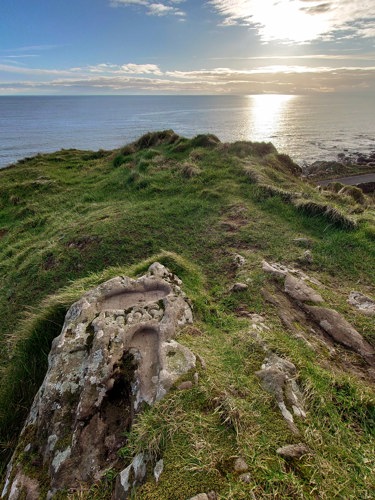
Gigha: Achamore Gardens, Kilchattan Chapel & the Ogham Stone
Distance: 5.20 km/3 ¼ miles | Time: 2+ hours (walking time)Ascent: 130m
Terrain: Easy paths, roads and tracks for the most part although the route over from the Ogham Stone and back down to Ardminish is uneven underfoot (island path improvements are underway).
Access: Easy walking. Note that there is wheelchair access on some of the roads/tracks and in the gardens but not over the hill from the Ogham Stone or up the steep steps to the garden viewpoint. You can do an out and back to avoid or park at the gardens.
Map/s: OS Landranger 62 (1:50 000) OS Explorer 357 (1: 25 000)
Start: Ardminish Ferry Terminal
Finish: Ardminish Ferry Terminal
Parking: Tayinloan or Ardminish Ferry Terminals
Grid Reference: NR 693 465 (Tayinloan) or NR 652 491 (Gigha)
Public Transport: Bus 449, ferry to Gigha
Toilets: At both ferry terminals and in the gardens.
Facilities: Bikes can be hired from the Gigha Boats & Activity Centre next to the terminal. There is also a new camp site. There are plenty of accommodation options. Meals and refreshments can be found at Ardminish Stores, The Nook, The Gigha Hotel and The Boathouse. Note some businesses are seasonal so check opening times in advance.
Getting there: To reach Tayinloan ferry terminal from Tarbert take the A83 south for 18 ½ miles then take the signposted route right to the ferry. From Campbeltown it is 18 ½ miles north on the A83 and to the left.
Route Description:
The stunning Isle of Gigha lies just off the west coast of Kintyre. The most southerly of the Hebridean islands it boasts an array of rugged coastlines and sandy beaches, all begging to be explored. Despite its small size - it is just seven miles long - Gigha is a wonderful place to relax and feel at one with nature. It has an excellent network of paths and tracks to explore by bike or on foot meaning you can leave your car behind. This walk from Ardminish allows for the exploration of the lovely Achamore Gardens as well as a glimpse of some of the older historical sites nearby.
As soon as you arrive at the small ferry terminal you are met with a coastline of sandy white beaches interspersed with rocky promontories. Here Dalradian rocks have been beaten by waves and weather to give the fine white sands which delight so many a visitor. Taking the single track road there are pubic facilities to your right and bike and boat hire to your left. Follow the road around the bay and the take the next left down towards The Boathouse. This is a wonderful spot from which to gaze back across the bay and in the main season it enjoys prime position for refreshment.
Taking a newly laid path right, just before The Boathouse, will bring you to another small beach, Rubha A’Chinn Mhoir. It lies just down from the path and is worth the views across its pretty white sands. You can cross the beach and take a little path right, keeping the buildings to your left, which will bring you back to the main path. It is then an easy walk up to the single-track road.
Turning left down the road you will pass a fire station on your left. Soon after a path can be taken into the woods on your right. Keep left to stay parallel to the road and the path will take you on a quiet woodland trail to Achamore Gardens, crossing the track to the village hall.
Keep an eye out for the Gruffalo’s child and The Furboch House, a little wooden caravan forming part of the OGAM (Our Gigha and Me) project to encourage learning and promote wellbeing in the outdoors.
The entrance to Achamore Gardens is soon reached where a map gives a choice of routes to explore. Admission is by donation. The lovely gardens were originally acquired by Sir James Horlick in 1944 to allow him to grow his collection of Rhododendron, Azalea, Camellia and many other species that enjoy the Gulf Stream and microclimate found on Gigha. It is worth taking time to explore; there are some fine prize-winning tree specimens and a feature pond where you might spot dragonflies. Essentially you will wish to finish at the walled gardens behind Achamore House to continue the walk.
Leaving the walled gardens through the back western wall you will espy a small path leading up to a viewpoint. Perched above is a carved wooden eagle which you soon pass, as the steep steps lead you to a welcome bench and a lovely panorama over Gigha’s western shores. Retreating down from the viewpoint turn left on the track below, keeping on the outside of the walled garden. This will lead you through some woods to a little gate at the garden’s north-western perimeter, onto a path past a house and down to a gravel track.
Turn right* and follow the track round to the right. Kilchattan Chapel is to your left. Dating back to the 13th Century the site has Christian connections that go back further to St Cathan, a 6th Century Irish missionary. Note the fine lancet window in the east gable end.
To visit the Ogham stone, return a few meters back up the track and take the righthand fork ahead, the path is signposted right. When you have gone through the gate the path up to the stone is immediately to your right. The Ogham Stone has an early medieval Ogham inscription; it is believed it may have been a personal monument. The Ogham script is primarily a Goidelic (ie Scottish and Irish Gaelic) writing form most commonly seen at sites in Ireland and is likely to have been brought with Irish settlers in the 5th and 6th centuries.
To continue drop down from the stone and turn right. Passing a deserted garden, the views soon open out as you leave the gorse behind, and a grassy track takes you over the slopes of Cnoc na Croise. Here it is recorded that there were once three prehistoric burial cairns, but nothing can be seen of them now. Grand views over the island allow vistas east and west. Below you will see the fields you will cross to return to Ardminish. Once down take the path that goes right after the Playpark (which can be seen to your right as you cross the fields) or head directly down to The Gigha Hotel (note upgrading of paths are currently underway for this section, see here).
Turning left it is now a short walk to Ardminish Stores, which has a wide array of snacks, and the turning right back down to the ferry terminal and The Boathouse.
*Turning left will take you to Cuddyport Beach and the Quern Stone Quarry, also worth exploring but which requires at least another couple of hours so is not included here.
The described route and accompanying information are there to be used as a guide. Please be aware that track and path closures can happen at any time. All walks are undertaken at your own risk.
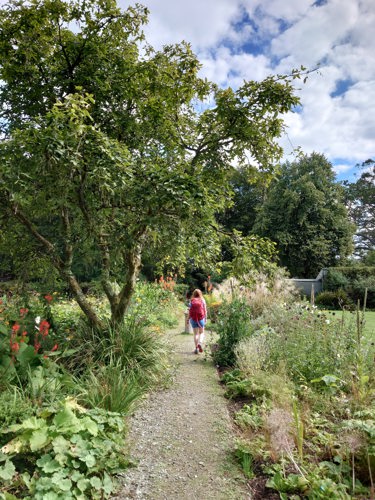
Short Walks in Kilmartin Glen & Inveraray
Kilmartin: Lady's Seat and Glebe Cairn
Distance: 5.2km / 3 miles | Time: 1½ to 2 hoursAscent: 150m
Terrain: Tracks and footpaths, steep in places
Access: This route is not suitable for wheelchairs or buggies other than on the main tracks and forestry road. There are two cattle grids without side gates (more problematic if you have a dog).
Map/s: OS Landranger 55 (1:50 000) OS Explorer 358 (1: 25 000)
Start: Car park opposite Kilmartin Hotel
Finish: Car park opposite Kilmartin Hotel
Parking: Car park opposite Kilmartin Hotel (further parking by new church - lane entrance opposite old church)
Grid Reference: NR 835 988
Public Transport: 23/423, 421, 429 (limited service at weekends)
Toilets: Yes
Facilities: Kilmartin Museum offers an in-depth insight into the area’s important history and showcases a range of important historical artefacts. They also have an excellent café. (Museum & café reopening 2023). Meals can also be had at the Kilmartin Hotel (seasonal?). Other nearby eateries include the Horseshoe Inn, Cairnbaan Hotel, Crinan Hotel, Lucy’s Ardfern with further shops and cafes in Lochgilphead and at Achnashelloch Farm. Nearby accommodation includes the aforementioned hotels, B&Bs and a wide range of self-catering options including the historic Kilmartin Castle, King’s Reach and Kirnan Estate.
Getting there: Kilmartin is 30 miles south of Oban on the A816, 8 miles north of Lochgilphead on the A816, 33 miles from Inveraray via the A83 and A816 and 32 miles south of Dalmally via the scenic route on the south side of Loch Awe (A85, A819, B840 & A816).
Route Description:
Kilmartin Glen has captured the human imagination for centuries and attracted people to settle in its valley and surrounding hills for several millennia. This walk takes you to a viewpoint known as Lady’s Seat. The higher vantage point makes it easier to see how the glen has been shaped by the last ice age as well as being a place to enjoy a quiet moment. You might want to be here as the sun rises or at sundown when golden light falls on the hills across the glen. It can easily be combined with other walks including the linear cemetery and standing stones to the south or Carnasserie Castle and the cup and ring marked stones of Ormaig to the north.
Before starting the walk seek out the viewpoint at the south end of the green next to the Church – this gives a direct view down the glaciated glen and a glimpse towards the burial cairns that form what is known as the linear cemetery. The latter refers to the burial cairns constructed over time in a linear fashion, stretching for some 2 ½ miles.
Return from the viewpoint to the carpark and turn left to pass the church and museum. Just after the museum follow a paved footway down to Kilmartin Garage. Immediately before the garage turn left by the water treatment works and through a kissing gate into a field. Ahead you will see Glebe Cairn.
This huge cairn was built in the Bronze Age some 4000 years ago. It had two burial cists most likely built for those held in high esteem. A jet necklace was found suggesting one is likely to have been for a woman. The jet, a black semi-precious organic gemstone formed through the fossilisation of trees similar to the Monkey Puzzle, indicates that trading extended at least as far as Whitby in Yorkshire from where the stones probably originated. This is the northernmost cairn of the linear cemetery.
From the cairn head down the field to Kilmartin Burn, cross the bridge and turn right. The path leads you back over the burn to a bigger track where you turn left. Continue north past woodland and the pits where gravel is now quarried from raised gravel terraces left behind after the last ice age. Here a giant pre-historic timber circle some 47m in diameter once stood along with burial cists and an avenue of pits signifying ritual and funerary purpose (Canmore).
Keep to the lefthand track ignoring a sign pointing right for the Dalriada Heritage Trail (next to barn) and continue over the cattle grid. After just 150m you will cross another cattle grid and then enter the forestry. Continue for a short distance and you will see a track heading up into the trees to your left. Take this – it is quite muddy after rain so wellies or walking boots are advised! The route meanders upwards passing a small path off to the right (to a small viewpoint which once had a circular structure) before reaching a small path up to your left leading to Lady’s Seat. If you reach the main track again you have gone too far!
The short walk through the trees soon brings you out to a clearing and Lady’s Seat, a series of large flat upright stones and a flat stone that creates the ‘seat’. The seat was possibly erected in the 19th Century for those visiting Poltalloch Estate to enjoy the view, but previous use of the stones is unclear.
Return via the same route or add on one of the other walks in the glen. The museum and café are excellent and will be reopening in 2023. The churchyard has some superb carved medieval stones in the Campbell Burial Aisle, built for Bishop Neil Campbell of the Isles (d. 1627), and in the Poltalloch Enclosure (Historic Environment Scotland).
The described route and accompanying information are there to be used as a guide. Please be aware that track and path closures can happen at any time. All walks are undertaken at your own risk.
Kilmartin: Linear Cemetry and Standing Stones
Distance: 4.7km / 3 miles | Time: 2 to 2½ hoursAscent: 30m
Terrain: Easy tracks and paths, grassy fields
Access: There is gated access to the sites off the main track and disabled parking available near Temple Woods. Further parking is available at Lady Glassary Wood. Some of the paths are quite narrow/between fences and the burial cairns themselves are stony mounds not accessible to wheelchairs or buggies. To gain access to the lower track joining the cairns from the museum take the main track left AFTER the garage and then the next left by the burn.
Note: the top entrance to Glebe Cairn is via a kissing gate and access from the bottom track is over a narrow bridge and through a gate.
Map/s: OS Landranger 55 (1:50 000) OS Explorer 358 (1: 25 000)
Start: Car park opposite Kilmartin Hotel
Finish: Car park opposite Kilmartin Hotel
Parking: Car park opposite Kilmartin Hotel (further parking by new church - lane entrance opposite old church)
Grid Reference: NR 835 988
Public Transport: 23/423, 421, 429 (limited service at weekends)
Toilets: Yes
Facilities: Kilmartin Museum offers an in-depth insight into the area’s important history and showcases a range of important historical artefacts. They also have an excellent café. (Museum & café reopening 2023). Meals can also be had at the Kilmartin Hotel (seasonal?). Other nearby eateries include the Horseshoe Inn, Cairnbaan Hotel, Crinan Hotel, Lucy’s Ardfern with further shops and cafes in Lochgilphead and at Achnashelloch Farm. Nearby accommodation includes the aforementioned hotels, B&Bs and a wide range of self-catering options including the historic Kilmartin Castle, King’s Reach and Kirnan Estate.
Getting there: Kilmartin is 30 miles south of Oban on the A816, 8 miles north of Lochgilphead on the A816, 33 miles from Inveraray via the A83 and A816 and 32 miles south of Dalmally via the scenic route on the south side of Loch Awe (A85, A819, B840 & A816).
Route Description:
The rich geological landscape in the Heart of Argyll has attracted humankind for many millennia. Once the ice receded after the last ice age plants and wildlife recolonised the landscape. Trees and wild grasses, heathers, mosses and lichens, many species like those we see today in our temperate Celtic rainforest. With a plentiful food supply so too would come larger animals closely followed by early humans, the hunter gatherers of the Mesolithic.
And to the west was a fjord like landscape dominated by the sea. Over time sea routes would develop and man would use the sea as the main means by which to find new territory, fish, and trade. But it is the Neolithic and Bronze Age settlers that capture the imagination throughout much of the glen and the era this particular walk encompasses. Cists (stone burial coffins), burial cairns, standing stones and mysterious cup and ring marks abound, shrouded in a mystery that we do not really understand. Some of the remains are believed to be over 5500 years old, others around 3000.
Before leaving the car park seek out viewpoint at the south end of the green next to the Church – this gives a fantastic view down the glaciated glen and a glimpse towards the burial cairns that form what is known as the linear cemetery. The latter refers to the number of burial cairns constructed over time in a linear fashion down the glen, stretching for some 2 ½ miles, which are the main attraction of this walk.
Return from the viewpoint to the carpark and turn left to pass the church and museum. Just after the museum follow a paved footway down to Kilmartin Garage. Immediately before the garage turn left by the water treatment works and through a kissing gate into a field. Ahead you will see Glebe Cairn.
This huge cairn was built in the Bronze Age some 4000 years ago. It had two burial cists most likely built for those held in high esteem. A jet necklace was found suggesting one is likely to have been for a woman. The jet, a black semi-precious organic gemstone formed through the fossilisation of trees similar to the Monkey Puzzle, indicates that trading extended at least as far as Whitby in Yorkshire from where the stones most likely originated. This is the northernmost cairn of the linear cemetery.
From the cairn head down the field to Kilmartin Burn, cross the bridge and turn left. After 400m you will see Nether Largie North Cairn to your left. This vast cairn has a modern concrete chamber protecting the cist inside. Of main interest are the axe heads that were carved on the coffin lid which may signify a person of importance, perhaps a metal worker, was buried here. You can go inside, just take care as the steps are steep.
Continue south and a little ahead, on the left, is Nether Largie Mid Cairn. Here a cist can be clearly seen (two cists were found). Bodies would have been placed in a foetal position and surrounded by precious or useful goods for the afterlife. The pile of stones that forms the cairn will be substantially smaller than it once was – many stones will have been repurposed, some in the track you have just followed.
Return to the track and continue south passing the school. Turn right on to the road. A little further on you will reach Temple Wood. Here there are two circles. The older one is now just outlined in the ground with concrete markers, whereas the more recent circle has 13 of its stones remaining. These are older than the cairns you have seen by some 1000 years.
We do not know what all the structures mean, although funerary rites and rituals must have played a very important part. The fact so much effort was put into each cairn, each cist, each carved stone, each circle, also speaks of a time when perhaps food was plentiful and there was time for such ritual. The different carvings and alignments are likely to allude to that human desire to understand and celebrate the local landscape, sun, moon and stars each playing an important part through the seasons.
Opposite Temple Wood you will see a gate and a path will lead you to the mystic Nether Largie Standing Stones. Here they have stood for some 3000 years, perhaps aligned for rituals to the sun and moon. Their placement is younger than the cairns but if you look carefully, you will see cup and ring marks, these are much older suggesting the rocks were moved here some 1500 years after being carved.
From the stones a grassy path leads you north across the field and past a wood to the ancient burial cairn of Nether Largie South. Built some 5500 years ago its very presence holds time. If you wish to explore a little the chambers of this huge cairn can be entered on the north side. It is likely that further stones were added to the site as the other cairns were built to give the alignment and presence for the linear cemetery.
Return via your outward route on the road and track back past the other cairns to Kilmartin.
To find out more it is highly recommended that a visit is made to Kilmartin Museum (when it reopens) as there is a wealth of information in addition to important artefacts recovered from some of the sites. And there is an excellent café too.
Before leaving Kilmartin why not visit the churchyard where you will find some fine examples of medieval carved stones and grave slabs. These can be found in the 17th Century Poltalloch Enclosure and the Campbell burial aisle (Historic Environment Scotland).
The described route and accompanying information are there to be used as a guide. Please be aware that track and path closures can happen at any time. All walks are undertaken at your own risk.
Kilmartin: Nether Largie Cairn (south), Standing Stones and Temple Wood
Distance: 1.25km / ¾ miles | Time: ½ to 1 hourAscent: Negligble
Terrain: Easy tracks and paths or walks across the fields.
Access: There is gated access and disabled parking available by Temple Woods and parking at Lady Glassary Wood. Note some of the paths are quite narrow/between fences and that the burial cairn itself is a stony mound and not accessible to wheelchairs or buggies.
Map/s: OS Landranger 55 (1:50 000) OS Explorer 358 (1: 25 000)
Start: Lady Glassary Wood car park
Finish: Lady Glassary Wood car park
Parking: Lady Glassary Wood car park
Grid Reference: NR 829 975
Public Transport: 23/423, 421, 429 (limited service at weekends)
Toilets: In Kilmartin
Facilities: A mile to the north Kilmartin Museum offers an in-depth insight into the area’s important history and showcases a range of important historical artefacts. They also have an excellent café. (Museum & café reopening 2023). Meals can also be had at the Kilmartin Hotel (seasonal?). Other nearby eateries include the Horseshoe Inn, Cairnbaan Hotel, Crinan Hotel, Lucy’s Ardfern with further shops and cafes in Lochgilphead and at Achnashelloch Farm. Nearby accommodation includes the aforementioned hotels, B&Bs and a wide range of self-catering options including the historic Kilmartin Castle, King’s Reach and Kirnan Estate.
Getting there: Kilmartin is 30 miles south of Oban on the A816, 8 miles north of Lochgilphead on the A816, 33 miles from Inveraray via the A83 and A816 and 32 miles south of Dalmally via the scenic route on the south side of Loch Awe (A85, A819, B840 & A816). This car park lies one mile south of Kilmartin on the B8025 (signposted Tayvallich & Crinan), just off the A816.
Route Description:
The rich geological landscape in the Heart of Argyll has attracted humankind for many millennia. Once the ice receded after the last ice age plants and wildlife recolonised the landscape. Trees and wild grasses, heathers, mosses and lichens, many species like those we see today in our temperate Celtic rainforest. With a plentiful food supply so too would come larger animals closely followed by early humans, the hunter gatherers of the Mesolithic.
To the west was a fjord like landscape dominated by the sea. Over time sea routes would develop and man would use the sea as the main means by which to find new territory, fish, and trade. And it is the Neolithic and Bronze Age settlers that capture the imagination throughout much of the glen. Cists (stone burial coffins), burial cairns, standing stones and mysterious cup and ring marks abound, shrouded in a mystery that we do not really understand. Some of the remains are believed to be over 5500 years old, others around 3000.
As you leave the car park there are some excellent information boards introducing you to the sites on this walk and within the linear cemetery. Crossing the road will take you to a couple of foot bridges leading to the fabulous Nether Largie Stones. Here they have stood for some 3000 years, perhaps aligned for rituals to the sun and moon. Their placement is younger than the cairns but if you look carefully, you will see cup and ring marks, these are much older suggesting the rocks were moved here some 1500 years after being carved.
From the stones a grassy path leads you north across the field and past some woods to the ancient burial cairn of Nether Largie South. Built some 5500 years ago its very presence holds time. If you wish to explore a little the chambers of this huge cairn can be entered on the north side. It is likely that further stones were added to the site as the other cairns were built to give the alignment and presence for the linear cemetery.
Exit the other side of the site and on reaching the road turn left. Continue for a short distance and you will reach Temple Wood. Here there are two circles and several burial cists. The northern and oldest circle – some 5000 years old - had timber posts and is now just outlined in the ground with concrete markers, whereas the more recent circle has 13 of its 22 stones remaining. Of interest is the fact another much larger wooden circle was built at Upper Largie on the gravel terrace now quarried north of Kilmartin which was some 47m across (Canmore). One burial cist, nicknamed the archers grave, was probably for a male; flint arrowheads were found as well as phosphate traces of where the person was laid to rest.
We do not know what all the structures mean, although funerary rites and rituals must have played a very important part. The fact so much effort was put into each cairn, each cist, each carved stone, each circle, also speaks of a time when perhaps food was plentiful and there was time for such ritual. The different carvings and alignments are likely to allude to that human desire to understand and celebrate the local landscape, sun, moon and stars each playing an important part through the seasons. One stone has a spiral carving signifying a potential connection with Ireland (Historic Environment Scotland).
Opposite Temple Wood you will see a gate and a path will lead you back to the mystic Nether Largie Standing Stones and across to the car park. Refreshments can be found in Kilmartin at the Kilmartin Hotel and the excellent Museum - when it reopens – has a café.
The described route and accompanying information are there to be used as a guide. Please be aware that track and path closures can happen at any time. All walks are undertaken at your own risk.
Kilmartin: Ri Cruin Cairn (extension)
Distance: 1.4km / ≈1 mile | Time: 20 to 30 minsAscent: 0m
Terrain: Road and narrow path over stile
Access: The stile and path are not suitable for wheelchairs or buggies
Map/s: OS Landranger 55 (1:50 000) OS Explorer 358 (1: 25 000)
Start: NA (add on for walks ii and iii above)
Finish: NA (add on for walks ii and iii above)
Parking: Car park opposite Kilmartin Hotel (further parking by new church - lane entrance opposite old church)
Grid Reference: NR 835 988
Public Transport: 23/423, 421, 429 (limited service at weekends)
Toilets: Yes
Facilities: Kilmartin Museum offers an in-depth insight into the area’s important history and showcases a range of important historical artefacts. They also have an excellent café. (Museum & café reopening 2023). Meals can also be had at the Kilmartin Hotel (seasonal?). Other nearby eateries include the Horseshoe Inn, Cairnbaan Hotel, Crinan Hotel, Lucy’s Ardfern with further shops and cafés in Lochgilphead and at Achnashelloch Farm. Nearby accommodation includes the aforementioned hotels, B&Bs and a wide range of self-catering options including the historic Kilmartin Castle, King’s Reach and Kirnan Estate.
Getting there: Kilmartin is 30 miles south of Oban on the A816, 8 miles north of Lochgilphead on the A816, 33 miles from Inveraray via the A83 and A816 and 32 miles south of Dalmally via the scenic route on the south side of Loch Awe (A85, A819, B840 & A816).
Route Description:
Extension to Ri Cruin Burial cairn from Temple Wood
To visit the southernmost cairn of Ri Cruin you will need to do three sides of a square on the road before returning to the main walk. This little visited cairn has its own charm amongst the trees.
Leaving Temple Wood follow the road to the T-Junction and turn left. Go 350m and cross a stone stile on your right, signposted to the cairn.
The most southerly of the cairns in the linear cemetery, Ri Cruin is believed to date back some 4000 years and had three burial cists. It was evidently a site of importance as there are carvings of seven axe heads in the most southerly of the cists. The cairn and cists were damaged due to agricultural works in the 18th and 19th centuries and even a lime kiln was built over it at one point. The current site has been restored to an approximation of how it would have been prior to the limekiln although much of the stone will have been repurposed elsewhere. (Canmore)
On returning to the road, turn right and continue for 150m. Turn left. After 400m cross the small bridge on the left (opposite a carpark). Ahead are the standing stones and continuation of the walk.
The described route and accompanying information are there to be used as a guide. Please be aware that track and path closures can happen at any time. All walks are undertaken at your own risk.
Inveraray: River Aray and Carloonan Bridge
Distance: 4.3km/2 2/3 miles | Time: 1¼ to 1½ hoursAscent: 50m
Terrain: Easy tracks and paths although can be muddy in places
Access: The path through Duchess Louise Wood is not suitable for wheelchairs - see Walk (ii) for an alternative
Map/s: OS Landranger 56 (1:50 000) OS Explorer 360 (1:25 000)
Start: Inveraray Castle car park or from Inveraray centre (approx. 1km)
Finish: Inveraray Castle car park or from Inveraray centre (approx. 1km)
Parking: Inveraray Castle car park (seasonal – fee for parking included with ticket for Castle or charged separately) or Inveraray centre car parks (approx. 1km)
Grid Reference: Castle car park: NN 095 093 (Inveraray: NN 095 085)
Public Transport: Bus service from Glasgow (926, 976) – CityLink. Local bus service (428, 486) - West Coast Motors
Toilets: Public Toilets are available in Inveraray or at the Castle gift shop (seasonal)
Facilities: Inveraray Castle (including the gardens and parking) is open from 30th March until 31st October. It has a gift shop and tearoom. Inveraray has a large number of historic buildings including Inveraray Jail and the Bell Tower. There are tearooms, restaurants, gift shops and hotels easily accessed from the centre including Brambles, The George, Campbell Coffee and two good Whisky shops. 8 miles up the road at Cairndow there is also Loch Fyne Oysters, The Tree Shop and Fyne Ales.
Getting there: Inveraray is 104km/65 miles west of Glasgow and 180km/112 miles west of Edinburgh on the A83. Oban, 60km/37 miles away, can be reached via the A819. To the south via the A83 are Lochgilphead, Kilmartin, Crinan, Tarbert and Campbeltown.
Route Description:
Leaving the north end of the castle car park turn left along the path by the river just before Garden Bridge. The River Aray is near the end of its journey into Loch Fyne here but originates in the higher hills overlooking Loch Awe and Cladich to the north, before tumbling down Glen Aray.
Continue past a right-hand bend in the river. Above to your left is Cherry Park, the old stables and coach house are now used as offices by Argyll Estates. A small path to your right takes you next to the river or you can continue along the main track straight ahead. If you wish to visit the old 18th Century icehouse a narrow path to your left leads to a gate just 50m through the trees; the icehouse lies just across the track, retrace your steps to continue.
Both the main track and riverside path lead you to Malt Land. On the riverside path you will pass the remains of one of the old bridges. At Malt Land several buildings were built with agriculture in mind starting with a coach house designed by John Adam around 1760. Further development included stables, cottages and a hay barn. Keeping on the track to the right of Malt Land go through the gate and along the edge of a couple of fields (it can be quite muddy). You will pass a series of Salmon Leaps. The River Aray was once a good salmon river but wild salmon numbers have decreased dramatically. According to the Scottish Government numbers of wild salmon have decreased in our rivers by 40% in the last four decades, a sobering thought. A wild salmon study is currently underway to study the effects of climate change and pollution.
At the end of the fields - passing another dismantled bridge which is still marked on the OS maps - go through the gate. Go straight ahead past the cottages keeping by the river. Soon you will come to the delightful little hexagonal Fishing Pavilion, a summer house built for the 5th Duke in 1803 by John Tavish. According to Canmore fishing in the pool at the foot of the falls ‘was reserved by the 6th Earl of Argyll in a 1577 feu-charter of Carloonan’. Please do not attempt to descend the steps leading to the pool; they are slippery with no protection.
Ahead you will come to the single arched Carloonan Bridge, built by William Douglas in 1755-57 and later widened at each end to take carriages. Turn right towards Carloonan Farm and soon you pass the impressive Doocot. Carloonan Dovecot was designed by Roger Morris in 1747 and built by William Douglas in 1748. Looking southeast you have a direct view along the Oak Avenue to the Garden Bridge, built a decade later. Either stay on the estate road to where Garden Bridge crosses the River Aray or take the slightly higher track signposting you to Dun na Cuaiche* then follow the signposted footpath right through the Duchess Louise Wood to rejoin the road and cross Garden Bridge. *Add in Dun na Cuaiche for lovely views over Inveraray and Loch Fyne towards the Arrochar Alps (it is quite a steep ascent but worth it if you have time).
Return to the car park or continue down the road through the beech hedges to visit the Castle, tearoom and gardens. On your right you will see the monument commemorating the execution by the 1st Marquis of Atholl of 17 Campbells in 1685.
The described route and accompanying information are there to be used as a guide. Please be aware that track and path closures can happen at any time. All walks are undertaken at your own risk.
Inveraray: River Aray to Malt Land
Distance: 1.7km/1 mile | Time: 30 minutesAscent: 13m
Terrain: A mixture of easy paths, tracks and road
Access: Accessible by wheelchair and buggy (the riverside path may get muddy after rain) - paved/pedestrian route from Inveraray
Map/s: OS Landranger 56 (1:50 000) OS Explorer 360 (1:25 000)
Start: Inveraray Castle car park or from Inveraray centre (approx. 1km)
Finish: Inveraray Castle car park or from Inveraray centre (approx. 1km)
Parking: Inveraray Castle car park (seasonal – fee for parking included with ticket for Castle or charged separately) or Inveraray centre car parks (approx. 1km)
Grid Reference: Castle car park: NN 095 093 (Inveraray: NN 095 085)
Public Transport: Bus service from Glasgow (926, 976) – CityLink
Local bus service (428, 486) - West Coast Motors
Toilets: Public Toilets are available in Inveraray or at the Castle gift shop (seasonal)
Facilities: Inveraray Castle (including the gardens and parking) is open from 30th March until 31st October. It has a gift shop and tearoom. Inveraray has a large number of historic buildings including Inveraray Jail and the Bell Tower. There are tearooms, restaurants, gift shops and hotels easily accessed from the centre including Brambles, The George, Campbell Coffee and two good Whisky shops. 8 miles up the road at Cairndow there is also Loch Fyne Oysters, The Tree Shop and Fyne Ales.
Getting there: Inveraray is 104km/65 miles west of Glasgow and 180km/112 miles west of Edinburgh on the A83. Oban, 60km/37 miles away, can be reached via the A819. To the south via the A83 are Lochgilphead, Kilmartin, Crinan, Tarbert and Campbeltown.
Route Description:
Leaving the north end of the castle car park turn left along the path by the river just before Garden Bridge. The River Aray is near the end of its journey into Loch Fyne here but originates in the higher hills overlooking Loch Awe and Cladich to the north, before tumbling down Glen Aray.
Continue past a right-hand bend in the river. Above to your left is Cherry Park, the old stables and coach house now used as offices by Argyll Estates. A smaller path to your right takes you next to the river or, for easier access, continue along the main track straight ahead. If you wish to visit the old 18th Century icehouse a narrow path to your left (not suitable for wheelchairs) leads to a gate just 50m through the trees; the icehouse lies just across the track, retrace your steps to continue.
Both the main track and riverside path lead you to Malt Land. On the riverside path you will pass the remains of one of the old bridges. At Malt Land several buildings were built with agriculture in mind starting with a coach house designed by John Adam around 1760. Further development included stables, cottages, ‘The Great Shade’ (shed), a hay barn and riding school. Some of the buildings have been repurposed, others dismantled, one destroyed by fire (and rebuilt) and the former coach house is now houses.
Cross the River Aray here. Once a good salmon river but wild salmon numbers have decreased dramatically. According to the Scottish Government numbers of wild salmon have decreased in our rivers by 40% in the last four decades, a sobering thought. A wild salmon study is currently underway to study the effects of climate change and pollution.
Upriver you will see the impressive Doocot. Carloonan Dovecot was designed by Roger Morris in 1747 and built by William Douglas in 1748. According to Canmore it has 410 square slab-built nesting-boxes in eleven tiers – so plenty of roosting spots!
Bearing right stay on the estate road all the way to where Garden Bridge crosses the River Aray or take the slightly higher track that signposts you to Dun na Cuaiche then follow the signposted footpath (not suitable for wheelchairs) right through the Duchess Louise Wood to rejoin the road and cross Garden Bridge. The bridge was designed by John Adam and built between 1758 and 1761 under the supervision of David Frew, an Edinburgh mason.
Either return to the car park or continue down the road through the beech hedges to visit the Castle, tearoom and gardens. On your right you will see the monument that formerly stood in the garden next to the Bank of Scotland in Inveraray. First erected in 1754, it commemorates the execution by the 1st Marquis of Atholl of 17 Campbells in 1685.
The described route and accompanying information are there to be used as a guide. Please be aware that track and path closures can happen at any time. All walks are undertaken at your own risk.
Inveraray: Dun na Cuaiche and the Watchtower
Distance: 4.9km/3 miles | Time: 1¾ to 2 hoursAscent: 249m
Terrain: A mixture of paths, tracks and road. Sustained ascent, some steep and uneven sections
Access: The narrow uneven path through the Duchess Louise Wood is not suitable for wheelchairs or buggies (all-terrain users may be able to explore further via the road).
Map/s: OS Landranger 56 (1:50 000) OS Explorer 360 (1:25 000)
Start: Inveraray Castle car park or from Inveraray centre (approx. 1km)
Finish: Inveraray Castle car park or from Inveraray centre (approx. 1km)
Parking: Inveraray Castle car park (seasonal – fee for parking included with ticket for Castle or charged separately) or Inveraray centre car parks (approx. 1km)
Grid Reference: Castle car park: NN 095 092 (Inveraray: NN 095 085)
Public Transport: Bus service from Glasgow (926, 976) – CityLink. Local bus service (428, 486) - West Coast Motors
Toilets: Public Toilets are available in Inveraray or at the Castle gift shop (seasonal)
Facilities: Inveraray Castle (including the gardens and parking) is open from 30th March until 31st October. It has a gift shop and tearoom. Inveraray has a large number of historic buildings including Inveraray Jail and the Bell Tower. There are tearooms, restaurants, gift shops and hotels easily accessed from the centre including Brambles, The George, Campbell Coffee and two good Whisky shops. 8 miles up the road at Cairndow there is also Loch Fyne Oysters, The Tree Shop and Fyne Ales.
Getting there: Inveraray is 104km/65 miles west of Glasgow and 180km/112 miles west of Edinburgh on the A83. Oban, 60km/37 miles away, can be reached via the A819. To the south via the A83 are Lochgilphead, Kilmartin, Crinan, Tarbert and Campbeltown.
Route Description:
From the Castle car park leave via the path at its northern corner towards the River Aray and bear right towards the bridge. The route is now marked with a series of blue arrows. In the field opposite there is a Cedar of Lebanon tree readily recognisable on account of its horizontal branching habit and its bluish-green foliage. It is thought that this tree and the Pine close by may have been planted by Queen Victoria to commemorate her visit to the Castle in 1875.
Continue left over the bridge, a fine stone arch known originally as the Garden Bridge, designed by John Adam and built between 1758 and 1761 under the supervision of David Frew, an Edinburgh mason.
Ahead follow a narrow footpath through the wood (not the wider one to your right). In May there will be a superb display of bluebells. Some of the mature trees in this area are limes, dating from a 17th century plantation through which vistas or Avenues were created. Leaving the woodland through a gate turn right along the track before bearing left across the field and up to a further gate. Carry on through the gate into the woodland.
This area is an old Pinetum (collection of conifer trees). Britain only has three native conifers, Scots Pine, Yew and Juniper and of these only the Pine could be classed as a timber tree, but even this species grows relatively slowly. During the 18th and 19th centuries explorers were fascinated by the large range of conifer trees they found throughout the World. Landowners were keen to grow trees from some of the seeds sent back to this country and form collections such as you see here.
On your left the ruined buildings are remains of a lime kiln. Quarried limestone was brought to the site and the kiln was lined with dry wood and filled with alternate layers of coal and limestone. A fire was lit at the base which gradually ‘burnt’ the lime. Once the kiln had cooled down the powdered lime would be removed from the bottom and stored in the adjoining shed. The kiln is thought to have been last used around 1912. PLEASE DO NOT CLIMB OVER THE BUILDINGS.
Continue up the track and enjoy further views over part of the Estate to he north until you reach the summit of Dun na Cuaiche and the Watchtower. The summit is 253m (830 feet) above sea level. The name literally means ‘the hill of the cup, bowl or quaich’ and is probably so called because of the hollowed-out shape at the top. The earth works that give this appearance may be due to excavation at the time the tower was built or much earlier Iron Age activity.
The tower itself was designed by Roger Morris and William Adam and was built in 1748. Its purpose was purely decorative and was cleverly sited on the edge of the steep face of the hill but not quite on top so that when seen from the Castle and Town it is silhouetted against the sky. From this commanding position it is possible to see how the landscape has evolved over the past 300 or so years.
The view across the Castle and beyond the Town down to Loch Fyne and across to the Arrochar Alps and through the glens speaks for itself.
To return retrace your steps down the same route. On crossing the Garden Bridge either return to the car park or continue down the road through the beech hedges to visit the Castle, tearoom and gardens. On your right you will see the monument that formerly stood in the garden next to the Bank of Scotland in Inveraray. First erected in 1754, it commemorates the execution by the 1st Marquis of Atholl of 17 Campbells in 1685.
Note: to make a longer walk you can easily combine this route with the Carloonan Bridge walk (starting with the latter).
The described route and accompanying information are there to be used as a guide. Please be aware that track and path closures can happen at any time. All walks are undertaken at your own risk.
Barnluasgan: Loch Barnluasgan Oakwood Trail & Bellanoch Viewpoint (optional)
Distance: 4.9km/3 miles | Time: 1¾ to 2 hoursAscent: 249m
Terrain: A mixture of paths, tracks and road. Sustained ascent, some steep and uneven sections
Access: The narrow uneven path through the Duchess Louise Wood is not suitable for wheelchairs or buggies (all-terrain users may be able to explore further via the road).
Map/s: OS Landranger 56 (1:50 000) OS Explorer 360 (1:25 000)
Start: Inveraray Castle car park or from Inveraray centre (approx. 1km)
Finish: Inveraray Castle car park or from Inveraray centre (approx. 1km)
Parking: Inveraray Castle car park (seasonal – fee for parking included with ticket for Castle or charged separately) or Inveraray centre car parks (approx. 1km)
Grid Reference: Castle car park: NN 095 092 (Inveraray: NN 095 085)
Public Transport: Bus service from Glasgow (926, 976) – CityLink. Local bus service (428, 486) - West Coast Motors
Toilets: Public Toilets are available in Inveraray or at the Castle gift shop (seasonal)
Facilities: Inveraray Castle (including the gardens and parking) is open from 30th March until 31st October. It has a gift shop and tearoom. Inveraray has a large number of historic buildings including Inveraray Jail and the Bell Tower. There are tearooms, restaurants, gift shops and hotels easily accessed from the centre including Brambles, The George, Campbell Coffee and two good Whisky shops. 8 miles up the road at Cairndow there is also Loch Fyne Oysters, The Tree Shop and Fyne Ales.
Getting there: Inveraray is 104km/65 miles west of Glasgow and 180km/112 miles west of Edinburgh on the A83. Oban, 60km/37 miles away, can be reached via the A819. To the south via the A83 are Lochgilphead, Kilmartin, Crinan, Tarbert and Campbeltown.
Route Description:
To enjoy the oakwood trail it is easiest to start along the well-kept path on the eastern (righthand) side of Loch Barnluasgan from the car park. You may spot the well camouflaged beaver lodge. Soon after entering the woodland take the small path that ascends to your right, indicated by a marker post. The steep path winds up steps through oak, hazel and birch before reaching a clearing. Look out for the remains of a felled tree that looks more like a contemporary sculpture to your right.
As the path leads you through the ancient woods you gain glimpses of Loch Linne below, through trees draped in lichens and moss. Overhead you may see buzzard or even osprey, whilst hidden in the trees woodland creatures including red squirrels and pine martens may be quietly watching you as you walk on by. A final rise leads you to a viewpoint overlooking Barnluasgan far below and a bench offers the weary a rest.
Now stony steps take you down, steeply at first, before returning to the Loch below. Turn right to continue round Loch Barnluasgan. After a little way you will see the wildlife hide set by the Loch, a good place to watch birds, and, if there at dusk, a place from which you might espy one of the local beavers or an otter.
You can now either take the out and back route up to Bellanoch Viewpoint (to your right) or turn back south (left) and continue past the water loving and wet meadowland plants to the car park. Dragon flies, bumble bees, hoverflies and butterflies, including the increasingly rare Marsh Fritillary Butterfly love this rich array of plant life.
Going the extra 1½ miles up the gravel track to the viewpoint takes you past the Argyll Beaver Centre (seasonal) where friendly rangers can give you a real insight to the area’s wildlife.
Bellanoch viewpoint offers a superb panorama overlooking the Moine Mhor (Great Moss) National Nature Reserve, an important peat bog habitat both for wildlife and as a vital carbon store. Directly below the River Add and Crinan Canal wend their way out to Loch Crinan. In the distance Scarba and Mull tempt the eye over western waters whilst the far-off peaks of northern Argyll can just be seen peeking above the smaller hills at the head of Kilmartin Glen and the heart of the Ancient Kingdom of Dalriada, Dunadd. In summer yachts can be seen plying the canal below but once this was a mainstay of freight from east to west that cut out the treacherous waters round the Mull of Kintyre. Pleasure cruises also became hugely popular after a visit by Queen Victoria in 1847. You may still be lucky enough to see a working puffer, The Vic 32.
The described route and accompanying information are there to be used as a guide. Please be aware that track and path closures can happen at any time. All walks are undertaken at your own risk.
Barnluasgan: Loch Coille-Bharr and Dubh Loch
Distance: 5.35km/3 1/3 miles | Time: 1 ½ to 2 hours (allow extra time for wildlife watching!)Ascent: 125m
Terrain: A mixture of gravel tracks, forestry tracks and steeper narrow paths with uneven surfaces.
Access: The full circuit is not wheelchair/buggy friendly although a section of forestry track can be accessed from the Loch Coille-Bharr car park. This can be quite muddy.
Map/s: OS Landranger 55 (1:50 000) OS Explorer 358 (1:25 000)
Start: Barnluasgan car park
Finish: Barnluasgan car park
Parking: Barnluasgan car park (or Loch Coille-Bharr car park)
Grid Reference: NR 790 909 (or NR 783 906)
Public Transport: Limited bus service (425/426) – West Coast Motors
Toilets: Public Toilets are available at Crinan Basin (5km/3 miles) and Tayvallich (9km/5 ½ miles) and at the Argyll Beaver Centre (seasonal – ¾ mile from Barnluasgan car park)).
Facilities: Information boards, Argyll Beaver Centre (¾ mile - seasonal)
Refreshments/meals are available at Crinan, Tayvallich, Polly’s Coffee Stop by the Crinan Canal (seasonal) and Cairnbaan.
Getting there: Barnluasgan is 11km/7 miles north of Lochgilphead. Heading north take the turning left off the A816 at Cairnbaan onto the B841. Follow the canal for 3 miles then turn left on to the B8025 towards Tayvallich. After 1 mile turn left at a junction by a memorial cross onto the minor road leading to Achnamara and Castle Sween. The car park is directly on your left. From the north take the B8025 off the A816 just south of Kilmartin, turn right over the canal onto the B841, left onto the B8025 then as above.
Route Description:
This lovely walk around Loch Coille-Bharr encompasses calm tranquillity, intriguing history and a wonderful array of plants and wildlife. The area is famed for its beavers, first released here in 2009, whose amazing dam work and evidence of activity can be clearly seen. If you are content to wait until dusk, you may see these illusive creatures as the light fades. Keep a look out for beaver activity as you walk, there is lots of evidence of their handiwork around!
Leaving the carpark at Barnluasgan cross the road you will see a little gate ahead into a field which meanders through the meadow before entering the edge of the woods. Here huge conifers and ancient oaks vie for position, the former planted many years after this Atlantic rainforest took root. Wend your way through the forest until you come out at a Forestry Track (the Loch Coille-Bharr car park is just to you right).
Turning left you will find yourself reaching ever further into the plantation and soon after comes the first surprise. Hidden amongst the trees of this relatively modern plantation you will find the old settlement of Kilmory Oib, with its well and ancient cross. The early Christian cross is of the medieval period and could go back as far as the 8th or 9th Centuries. There are animals and pairs of birds as well as a double transome (double cross), which is quite unusual.
It is worth exploring this old village and a little path takes you down to it before re-emerging on the forest track. Once some seventeen housed families here, with the settlement dating from around the late 16th Century until the mid-19th Century. More importantly is why it was abandoned. It seems that many who lived here also had family and friends at the nearby settlement of Arichonan. There the residents were evicted by the Malcolms of Poltalloch in 1848 to make way for sheep. Families from both villages rioted with some arrests. The exact date of the last resident is not known but it seems everyone had been moved on by the mid-19th Century. You can see some evidence of how the houses were later used as sheep enclosures with their lowered doorways. Now the ruined walls silently look on, amongst the Crab Apple, Sitka and Blackthorn.
Continuing down the track brings you to the ruins of Coille Bharr (Kilmory) Mill. This is thought to date back to at least the late 15th Century but is probably much older. Purportedly Lady Catherine Campbell, the 2nd Earl of Argyll’s daughter, took a night’s shelter there whilst escaping to Inveraray. The well-known tale tells of her rescue by fishermen from ‘Lady’s Rock’ off the south tip of Lismore, where her then husband Lachlan ‘Cattanach’ Maclean of Duart had sought to drown her. But revenge was meted out and Lachlan himself was later murdered.
Beside the mill the water that tumbles down the stream from the Loch above was once channelled to the wheel that would have ground corn. Now the mills’ walls are tumbling down too but it still retains the old archway. A little path leads up to Loch Coille-Bharr and it is a wonderfully tranquil spot to spend a little time before continuing.
On passing the mill the stream disappears down waterfalls to the right, quite a sight when there has been much rain. And a little further on the track splits, one leading off right to the Faery Isles, which lie to the south, the other left and round the bottom of Loch Coille-Bharr. The walk through the woods passes some fabulous old walls before reaching the Loch’s southernmost tip. The view up the Loch is quite lovely and makes you realise just how long and thin it is. And evidence of the beavers tackling a few rather large trees can also be seen; some have had to be cut down as they were getting a bit dangerous!
Continuing round the bottom of the Loch takes you up and over a little peninsula and then back down to a forestry track. Turning left keep your eyes open for gaps in the trees. As the Loch comes into view you will see one of the beaver lodges at the end of the little peninsula that you crossed. It is hard to miss as a mass of sticks! It seems just one of the beavers has taken on this large enterprise now that mum and dad et al have moved to different quarters. Quite a task.
The path soon leaves conifers behind and enters birch, hazel and oak. The colours are beautiful here from golds to greens to silvers depending on the season. Rich lichens and mosses abound interspersed with bilberry and fern.
Eventually the path will drop you down to a floating platform. If you are here at dusk pause, beavers can sometimes be seen swimming up and down the loch, but you will need to be quiet! To your right you will see the fabulous dam they built when they first came to the area. Behind this sits Dubh Loch. A walkway and seats allow for respite and quiet contemplation. Look out for waterfowl, dragon flies and damsel flies. In summer you may see lots of toads too, sometimes in their hundreds.
The last section of track will take you back up to the road, passing signs of further beaver work where they have been chopping trees and making channels. Once at the road it is just a short walk straight on back to the car park.
If you fancy a longer walk you can add on the walks round Loch Barnluasgan or even go down to Faery Isles. And look out for guided walks and courses being run in the area or drop into the Argyll Beaver Centre (seasonal) for more information.
The described route and accompanying information are there to be used as a guide. Please be aware that track and path closures can happen at any time. All walks are undertaken at your own risk.
Short Walks on Mull & Iona
Fionnphort - Via Loch Pottie to the Lazy Cow Cafe
Distance: 4.7km / 3 miles | Time: 1½ to 2 hours (excluding cafe stop!)Ascent: 40m
Terrain: Newly paved path, pavement and single-track road
Access: Wheelchair/buggy friendly. Note: the section up to the café is on a single-track road.
Map/s: OS Landranger 48 (1:50 000) OS Explorer 373 (1:25 000)
Start: Fionnphort car park
Finish: Fionnphort car park
Parking: Fionnphort car park
Grid Reference: NM 302 231
Public Transport: Bus service 496 (not Sundays)
Toilets: Toilets are available at Fionnphort
Facilities: There are a number of places to eat, drink, stay in/near Fionnphort but check opening dates as many are seasonal. They include The Keel Row and the recently opened Lazy Cow Café that this walk goes to. Look out for the Creel Seafood Bar near the Ferry Terminal in the main season and the Ninth Wave Seafood Restaurant (bespoke group bookings). If you wish to camp Fidden Farm offers spectacular views with lovely beaches nearby (bear in mind the prevailing wind is south-westerly so it can get breezy – don’t forget a few spare tent pegs!). There are several self-catering options or retreats on the Ross of Mull, Erraid and Iona.
Getting there: The A849 runs from Craignure on the east side of the Island to Fionnphort in the west. It is 35 miles. A car ferry connects Craignure and Oban and a passenger ferry connects Fionnphort and Iona.
Route Description:
The stunning scenery on the Ross of Mull has been created over millions of years, a rugged mix of ancient rocks that have been pushed together, folded, metamorphosed, and pushed apart again by volcanic activity and intrusions before succumbing to extensive weathering and glaciation. The diversity of rocks and the warm pinks and reds of the granite intrusions give this area a wilderness feel, the low-lying hills of the Ross lumpy, gnarled and wind swept.
Just inland from this rugged coast is the delightful Loch Pottie. Its Gaelic name Loch Poit na h-I is thought to relate to when the Monks first came to this area in the 6th Century and found good fishing here. It is thought to mean the ‘Pot of Iona’. St Columba is most likely to have gained permission to set up the monastery on Iona from King Conall mac Comgaill (the King of Dalriada based at Dunadd near Kilmartin) (St Columba’s Scotland) and it would have been a bonus if the monks had then found that not only did they have a source of fish from the sea but also a supply of freshwater fish on nearby Mull. This must have been very handy when the seas were too rough to head out west.
From Fionnphort carpark turn right and then right again onto the main road from Craignure. Heading east follow the pavement to the end of the houses. Just after the last house you will clearly see the newly paved Loch Pottie Path to your right, which is well signposted. It is now an easy meander down towards the loch and then along its northern side. Keep an eye out for waterfowl, otter, dragonflies and butterflies. Depending on the time of year you may hear Lapwings, Curlew or Corncrakes and keep your eyes tuned to the sky once in a while, this is also the domain of golden and sea eagles.
You will pass St Ernan’s Church, named after St Columba’s uncle who was one of the twelve followers who helped Columba set up the monastery on Iona. Built of local granite on land owned by the Duke of Argyll it was opened in 1899. The Duke made strict stipulations for its maintenance and use and there was a feu to be paid each year – if this was not forthcoming then the church and land would be returned to the Duke with no appeal (Mull Historical and Archaeological Society).
At the end of the loch the path returns to the road. If you wish to continue to the café (450m) go through the gate and cross the road (otherwise return the way you came or continue on the longer Loch Pottie circuit marked on our map in red). Take the single-track road ahead signposted to Kintra. You will pass Creich Hall on your left, the war memorial and a white cottage on your right. As the road veers slightly left look out for a track up to you right leading to the café. Return the way you came.
The described route and accompanying information are there to be used as a guide. Please be aware that track and path closures can happen at any time. All walks are undertaken at your own risk.
Fionnphort to Fidden Beaches
Distance: 5km / 3 miles | Time: 1½ to 2 hoursAscent: 45m
Terrain: Easy road and tracks. Uneven ground down to shore.
Access: Wheelchair/buggy friendly on the road and tracks but uneven ground down to the beaches.
Map/s: OS Landranger 48 (1:50 000) OS Explorer 373 (1:25 000)
Start: Fionnphort car park
Finish: Fionnphort car park
Parking: Fionnphort car park
Grid Reference: NM 302 231
Public Transport: Bus service 496 (not Sundays)
Toilets: Toilets are available at Fionnphort
Facilities: There are a number of places to eat, drink, stay in/near Fionnphort but check opening dates as many are seasonal. They include The Keel Row and the recently opened Lazy Cow Café. Look out for the Creel Seafood Bar near the Ferry Terminal in the main season and the Ninth Wave Seafood Restaurant (bespoke group bookings). If you wish to camp Fidden Farm offers spectacular views with lovely beaches nearby (bear in mind the prevailing wind is south-westerly so it can get breezy – don’t forget a few spare tent pegs!). There are several self-catering options or retreats on the Ross of Mull, Erraid and Iona.
Getting there: The A849 runs from Craignure on the east side of the Island to Fionnphort in the west. It is 35 miles. A car ferry connects Craignure and Oban and a passenger ferry connects Fionnphort and Iona.
Route Description:
The stunning scenery on the Ross of Mull has been created over millions of years, a rugged mix of ancient rocks that have been pushed together, folded, metamorphosed, and pushed apart again by volcanic activity and intrusions before succumbing to extensive weathering and glaciation. The diversity of metamorphosed rocks and the warm pinks and reds of the granite intrusions give this area a wild feel interspersed with stunning white beaches and rocky inlets. For the budding geologist there is much to explore but even for those with little knowledge it is hard not to get drawn in by the rocks of this stunning coastline. Of course, sandy beaches mean that the force of the sea has been hard at work and this southwest corner can certainly catch the wind with huge breakers, as those that take to the sea will know.
This easy walk takes in the track leading south from Fionnphort to Fidden, which then leads you down to the superb beaches with views to Iona, the west and south to Erraid. Turning south (left) out of the carpark it is literally a case of following the road to explore the beaches near Fidden or until you want to turn round. It is worth going down to the bay south of Fidden Farm for a better view over to Erraid*.
he beaches and inlets here are also good spots to snorkel or swim, although you will not want to disturb any seals if they are basking on the rocks; that is their time for regaining energy before they need to hunt again. Sunsets here are truly stunning so if you have the opportunity to camp here it is a great way to really enjoy this corner of Mull.
*If you wish to explore Erraid it is possible to drive down to the south end of the road to Knockvologan Farm but there is very limited parking. Erraid is tidal so this needs to be taken into account. Walking from Fionnphort to Erraid and exploring the Island is around a 10-mile return walk. There is also a stunning bay on the south of Erraid nicknamed David Balfour’s Bay after the main character in ‘Kidnapped’ by Robert Louis Stevenson, where part of the book was based.
The described route and accompanying information are there to be used as a guide. Please be aware that track and path closures can happen at any time. All walks are undertaken at your own risk.
Loch Pottie Circular
Distance: 9km / 5½ miles | Time: 2½ to 3½ hoursAscent: 95m
Terrain: Mixture of road, paved path and farm tracks.
Access: This route may be possible for powered all terrain/off-road wheelchairs but there are a number of gates and the tracks between the road ends are uneven and can get wet and muddy.
Map/s: OS Landranger 48 (1:50 000) OS Explorer 373 (1:25 000)
Start: Fionnphort car park
Finish: Fionnphort car park
Parking: Fionnphort car park
Grid Reference: NM 302 231
Public Transport: Bus service 496 (not Sundays)
Toilets: Toilets are available at Fionnphort
Facilities: There are a number of places to eat, drink, stay in/near Fionnphort but check opening dates as many are seasonal. They include The Keel Row and the recently opened Lazy Cow Café. Look out for the Creel Seafood Bar near the Ferry Terminal in the main season and the Ninth Wave Seafood Restaurant (bespoke group bookings). If you wish to camp Fidden Farm offers spectacular views with lovely beaches nearby (bear in mind the prevailing wind is south-westerly so it can get breezy – don’t forget a few spare tent pegs!). There are several self-catering options or retreats on the Ross of Mull, Erraid and Iona.
Getting there: The A849 runs from Craignure on the east side of the Island to Fionnphort in the west. It is 35 miles. A car ferry connects Craignure and Oban and a passenger ferry connects Fionnphort and Iona.
Route Description:
The stunning scenery on the Ross of Mull has been created over millions of years, a rugged mix of ancient rocks that have been pushed together, folded, metamorphosed, and pushed apart again by volcanic activity and intrusions before succumbing to extensive weathering and glaciation. The diversity of metamorphosed rocks and the warm pinks and reds of the granite intrusions give this area a wilderness feel, the low-lying hills of the Ross lumpy and gnarled.
Yet just inland from this rugged coast is the delightful Loch Pottie. Its Gaelic name Loch Poit na h-I is thought to relate to when the Monks first came to this area in the 6th Century and found good fishing here. It is thought to mean the ‘Pot of Iona’. Having most likely gained permission to set up the monastery on Iona from King Conall mac Comgaill (the King of Dalriada based at Dunadd near Kilmartin), (St Columba’s Scotland) it would have been a bonus if the monks had then found that not only was there a source of fish from the sea but also a supply of freshwater fish nearby. This must have been very handy when the seas were too rough to head out west.
From Fionnphort carpark turn right and then right again onto the main road from Craignure. Heading east follow the pavement to the end of the houses. Just after the last house you will clearly see the newly paved Loch Pottie Path, which is well signposted. It is now an easy meander down towards the loch and then along its northern side. Keep an eye out for waterfowl, otter, dragonflies and butterflies. Depending on the time of year you may hear Lapwings, Curlew or Corncrakes and keep your eyes tuned to the sky once in a while, this is also the domain of golden and sea eagles.
You will pass St Ernan’s Church, named after St Columba’s uncle who was one of the twelve followers who helped Columba set up the monastery on Iona. Built of local granite on land owned by the Duke of Argyll it was opened in 1899. The Duke made strict stipulations for its maintenance and use and there was a feu to be paid each year – if this was not forthcoming then the church and land would be returned to the Duke with no appeal (Mull Historical and Archaeological Society).
At the end of the loch the path returns to the road (note, if you want to visit the Lazy Cow Café it is 450m up the Kintra Road straight ahead from you). Turn right and follow the main road east for 600m. You will come to a single-track road on your right clearly signposted to Pottie with the blue cycle and walking sign to Fionnphort.
Initially paved the farm track takes you through a gate and rises past native woodland to Pottie. As you gain higher ground do remember to look back to the northeast towards the higher hills and Ben More. Between the two Potties the woods open out to a larger field, keep an eye out for the prehistoric granite standing stone to your right. Eventually the track will curve round the small, rugged hill of Torr Mor. At the southern end the track splits and you turn right back towards the sea, skirting the wooded slopes of the hill.
As you leave the trees behind the vista opens out right down to Fidden and across to Erraid. It is a pleasant walk, albeit sometimes muddy, passing the old ruins that lie between Pottie and the paved road. On reaching the paved road bear right* and you will pass the ruins of Toba Bhreaca, once a thatched 19th century Cottage (Canmore ID 21771)
The road now leads you on towards Fidden and the lovely beaches in this delightful corner. For the budding geologist there is much to explore but even for those with little knowledge it is hard not to get drawn in by the rocks of this stunning coastline. Of course, the sandy beaches mean that the force of the sea has been hard at work and this southwest corner can certainly catch the wind. But it is also a place in which to pause and enjoy the views, the wildlife and the clear waters. If you have thought to bring swimming gear, then there are some lovely spots along here.
Continuing past Fidden it is only a couple of kilometres back to the carpark and Fionnphort.
*longer walks to the south can also take in Erraid or the remote beach of Tràigh Gheal, note Erraid is a tidal Island and that both require a full day if walking from Fionnphort. It is possible to drive down to the south end of the road to Knockvologan Farm and walk from there but parking is limited. Walking from Fionnphort to Erraid and exploring the Island is around a 10-mile return walk and the return walk from Fionnphort to Tràigh Gheal is 11¼ miles.
The described route and accompanying information are there to be used as a guide. Please be aware that track and path closures can happen at any time. All walks are undertaken at your own risk.
Short Walks on Oban & Lorn
Dunstaffnage Circular
Distance: 1.4km / 1 mile | Time: 25+ minutes (add time to explore sites)Ascent: 9m
Terrain: Easy paths. Can be muddy through the wood.
Access: Wheelchair and buggy access from the car park to the Castle grounds. Note the woodland section of the route and Chapel are not easy to access and the Castle itself is not appropriate for wheelchairs due to the number of steps. The Ocean Explorer Centre is fully accessible to wheelchairs and is at ground level.
Map/s: OS Landranger 49 (1:50 000) OS Explorer 359 (1: 25 000)
Start: Dunstaffnage car park (further parking nearby)
Finish: Dunstaffnage car park (further parking nearby)
Parking: Dunstaffnage car park (further parking nearby)
Grid Reference: NM 881 341
Public Transport: Bus 405/005 Oban to/from Dunbeg
Toilets: Ocean Explorer Centre (during opening hours)
Facilities: Ticket office to visit the Castle (check seasonal opening times) and the Ocean Explorer Centre (weekdays) has excellent displays and entry is free. The centre also has a café.
Getting there: Dunstaffnage lies just to the northwest of Dunbeg off the A85 halfway between Oban (3.5 miles) and Connel (3 miles). Take the turning off the A85 to Dunbeg that leads onto Kirk Road. Follow this right to the end where the car park is situated.
National Cycle Network Route 78, Oban to Dunbeg.
Route Description:
This coastal walk may be short but allows for views over waters that have been strategic in their importance and plied by seagoing vessels for many centuries whether for trade, fishing, Christendom or in a bid to rule, seize or overthrow. By the time Dunstaffnage Castle was built by the MacDougalls in the mid-13th Century the birlinn (west highland galley) was the usual means of transport for trade, cattle, goods and, of course, battle.
Dunstaffnage Castle itself was a Royal stronghold and an important one guarding the entrance to Loch Etive and the northern access to the Pass of Brander. It saw many battles and was besieged by Robert the Bruce following his victory at the Pass of Brander over the MacDougalls in 1308. It then remained in Royal hands for some years before being passed to the Campbells with the nearby Chapel, also originally built by the MacDougalls. Famously Flora MacDonald was held prisoner here in 1746, having helped Bonnie Prince Charlie escape over to Skye.
Later WWII saw RAF Coastal Command Oban using the area for its flying boat (seaplane) base which were used to patrol the North Atlantic. Just to the south Ganavan Bay offered shelter for repair and maintenance where both a hangar and slipway were built. As a reminder of such times several wrecks lie in the waters off Dunstaffnage including the 402’ long S.S.Breda, a Dutch cargo-passenger ship sunk during WWII, and flying boats, which may be war graves. Nowadays it is mainly ferries, yachts, leisure craft and fishing vessels that take to the seas but you can imagine the scenes of old battles.
From the car park an easy and well-maintained track takes you all the way to Dunstaffnage Castle. Despite the maturing woodland disguising the views one can immediately see that it is in a prominent position over the sea to west, north and east and the choice of position by Duncan MacDougall - grandson to Somerled, Lord of the Isles - was most certainly strategic.
Following the takeover of Dunstaffnage Castle by the Campbells rivalry between clans and within families continued and it was here in 1463 that it is believed John Stewart, Lord of Lorn, was murdered having come to the Castle to wed to ensure that his (illegitimate) son would inherit his title. Three centuries later feuds between the clans culminated in the Appin Murder. Appin lands were put under the charge of Colin Roy Campbell (aka the ‘Red Fox’) for the collection of taxes following the defeat of the Jacobites at Culloden in 1746. The Jacobite ‘45 Rebellion had been supported by the Stewarts of Appin; this had been some of their remaining territory. Colin Roy Campbell met his end in 1752 killed by a fatal shot. For this ‘James of the Glen’, the then head of the Stewarts of Appin, was made scapegoat. To make an example to others he was hung for a crime he did not commit, his body left for 18 months until no more than dangling bones. It is not known who fired the shot.
You can buy tickets to see the interior of the Castle or just walk around its impressive walls and grounds. The Chapel lies on the small path leading away from the southwest corner of the Castle and has excellent examples of dog-toothed ornamentation. It had a burial aisle added by the Campbells in the 18th Century.
From the Chapel return slightly towards the Castle then take a small path leading left into the woods to the northwest. This allows you to continue west around the headland and visit the small coves and promontories which give views across the waters that were strategically so important. The path takes you through old woodland and brings you out at Camas Rubha na Liathaig (bay of the grey headland), which has a fine panoramic view looking towards Lismore with the hills of Mull and Morvern beyond.
Halfway round the bay a small path takes you inland to the buildings that include the Ocean Explorer Centre, Beach Café and Scottish Association for Marine Science (SAMS). The centre is open during weekdays and is well worth a visit to gain an insight into the geography and wildlife of our oceans and seas. It also has an Arctic cinema showing short films. From here it just a short walk back up the road to the car park.
The described route and accompanying information are there to be used as a guide. Please be aware that track and path closures can happen at any time. All walks are undertaken at your own risk.
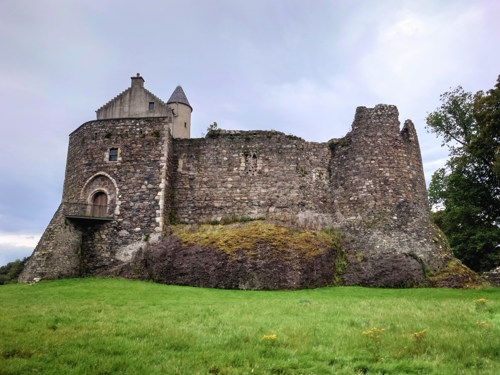
Sutherland's Grove and Gleann Dubh Reservoir
Distance: 4km / 2½ mile | Time: 1½ to 2 hoursAscent: 156m
Terrain: Forestry roads and paths, steep and uneven in places, steps
Access: Not suitable for wheelchairs or buggies
Map/s: OS Landranger 49 (1:50 000) OS Explorer 376 (1: 25 000)
Start: Sutherland’s Grove car park
Finish: Sutherland’s Grove car park
Parking: Sutherland’s Grove car park
Grid Reference: NM 965 421
Public Transport: Bus 405/410 (918 City Link) – note
Toilets: No (nearest are Port Appin)
Facilities: Benderloch to the south and Port Appin to the north both have local stores. If you want to eat out Port Appin has a couple of excellent restaurants at The Pierhouse Hotel and Airds Hotel and Restaurant, and a lovely craft and coffee shop, The Lighthouse – Appin Craft Shop.
Getting there: Sutherland’s Grove forestry car park is signposted just over the bridge at the north end of Barcaldine on the east side of the A828. It is 12 miles north of Oban on the road to Fort William (or 32 miles south of Fort William). Note this is a fast road.
Route Description:
This lovely woodland walk takes in the towering Douglas Fir trees planted in Sutherland's Grove, the riverside path up Gleann Dubh to the gorge and then on to the superb views from the reservoir. Some of the trees were planted in memory of Lord Sutherland who helped set up the Forestry Commission in 1919 and held the position of Assistant Commissioner (for Scotland) then Chief Commissioner until 1942.
Starting behind the information boards the path meanders up through the woods of Glen Dubh, climbing high above the river with glimpses down into the gorge below. Eventually you will reach a crossroads in the path. Taking the right path follow steps down to the gorge where you can get a good view of the falls as they tumble down below you.
Continue over the bridge and follow the route marked with blue marker posts, first heading south before a steep bend left takes you up on to a forestry road. Here views start to open out over Loch Creran.
Follow the road for just under 400m where you will come to a T-junction. Turn left and follow the road down until just before the bridge over the river (which is a continuation of the Forestry ‘Troll Route’ marked by the blue markers). Instead of crossing the river turn right at the signpost marked ‘reservoir’ and follow the track uphill.
When you come to a fork take the right-hand track. The route up will briefly steepen before bringing you to the level of the reservoir. You will want to take the first track on your left which leads to the edge of the reservoir. There are a couple of pleasant spots overlooking the reservoir to enjoy the views of the higher hills of Creach Bheinn and Beinn Bhreac. Below views sweep out over to Loch Creran and Appin.
Continue part way round the reservoir and a steepish path drops you down its flanks to a lower narrow track. Turn right along this and continue past the reservoir. Ignoring another path up follow the track down until you once more meet the forestry roads. Turn right then immediately left.
You will now have re-joined the blue marked ‘Troll Trail’, which leads you back down to the north end of Sutherland’s Grove where you will cross the access road. The last section meanders back through the grove by the waters of the Abhainn Teithil to the car park.
The described route and accompanying information are there to be used as a guide. Please be aware that track and path closures can happen at any time. All walks are undertaken at your own risk.
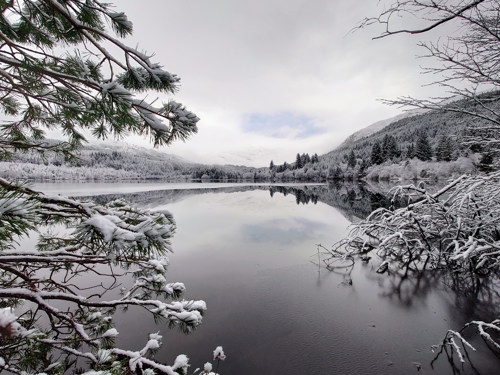
Sutherland's Grove River Walk
Distance: 2km /1¼ miles | Time: ¾ to 1 hourAscent: 60m
Terrain: Forestry roads and paths, steep and uneven in places, steps
Access: Not suitable for wheelchairs or buggies
Map/s: OS Landranger 49 (1:50 000) OS Explorer 376 (1: 25 000)
Start: Sutherland’s Grove car park
Finish: Sutherland’s Grove car park
Parking: Sutherland’s Grove car park
Grid Reference: NM 965 421
Public Transport: Bus 405/410 (918 City Link) – note
Toilets: No (nearest are Port Appin)
Facilities: Benderloch to the south and Port Appin to the north both have local stores. If you want to eat out Port Appin has a couple of
excellent restaurants at The Pierhouse Hotel and Airds Hotel and
Restaurant, and a lovely craft and coffee shop, The Lighthouse –
Appin Craft Shop.
Getting there: Sutherland’s Grove forestry car park is signposted just over the bridge at the north end of Barcaldine on the east side of the
A828. It is 12 miles north of Oban on the road to Fort William
(or 32 miles south of Fort William). Note this is a fast road.
Route Description:
This lovely woodland walk takes in the towering Douglas Fir trees planted in Sutherland's Grove, the riverside path up Gleann Dubh to the gorge and then on to the superb views from the reservoir. Some of the trees were planted in memory of Lord Sutherland who helped set up
the Forestry Commission in 1919 and held the position of Assistant Commissioner (for Scotland) then Chief Commissioner until 1942.
Douglas Firs themselves are native to North America and can grow to immense heights of 100m or more given the right conditions. One, known as the Lynn Valley Tree, in British Columbia, grew to an astonishing 126.5m – that’s over 415 feet tall! (C. Michael Hogan,
September 17, 2008). Their British name was given to them when the botanist David Douglas brought samples to Britain in 1827. The damp mild climate on Scotland’s west coast suits them well, as it does many types of conifers.
Starting behind the information boards the path meanders up through the woods of Glen Dubh, climbing up above the river with glimpses down into the gorge below as the route steepens.
Eventually you will reach a crossroads in the path. If you wish to gain a really good view of the gorge and waterfalls follow steps down to the gorge where you can gaze at the falls as they tumble below you.
Returning up the steps now take the righthand path that continues up the river (marked river walk). The path evens out here and it is a pleasant stroll with some lovely spots to enjoy the dappled light on the water.
The path ends at a T-junction with a forestry road. Turning left you will now have re-joined the blue markers of the ‘Troll Trail’. The road leads straight ahead through the trees before bending left. Ignoring several turnings to your right the markers will lead you on the forestry track as it
turns back south. Eventually a path to your right drops you back down to the north end of Sutherland’s Grove where you will cross the access road. The last section meanders back through the grove by the waters of the Abhainn Teithil to the car park.
The described route and accompanying information are there to be used as a guide. Please be aware that track and path closures can happen at any time. All walks are undertaken at your own risk.
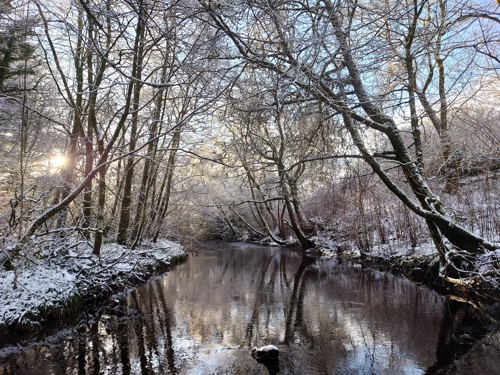
Sutherland's Grove 'Great Fir Trail'
Distance: 0.5km/1/3 mile | Time: 10-15minsAscent: 8m
Terrain: Easy path/track though the grove, can be muddy in places
Access: Access suitable for wheelchairs or buggies
Map/s: OS Landranger 49 (1:50 000) OS Explorer 376 (1: 25 000)
Start: Sutherland’s Grove car park
Finish: Sutherland’s Grove car park
Parking: Sutherland’s Grove car park
Grid Reference: NM 965 421
Public Transport: Bus 405/410 (918 City Link) – note
Toilets: No (nearest are Port Appin)
Facilities: Benderloch to the south and Port Appin to the north both have local stores. If you want to eat out Port Appin has a couple of excellent restaurants at The Pierhouse Hotel and Airds Hotel and Restaurant, and a lovely craft and coffee shop, The Lighthouse – Appin Craft Shop.
Getting there: Sutherland’s Grove forestry car park is signposted just over the bridge at the north end of Barcaldine on the east side of the A828. It is 12 miles north of Oban on the road to Fort William (or 32 miles south of Fort William). Note this is a fast road.
Route Description:
With easy access from the car park you can enjoy the woodland and nearby waters of the Abhainn Teithil on this lovely short circuit through the towering Douglas Fir trees planted in Sutherland's Grove. Some of the trees were planted in memory of Lord Sutherland who helped set up the Forestry Commission in 1919 and held the position of Assistant Commissioner (for Scotland) then Chief Commissioner until 1942.
Douglas Firs themselves are native to North America and can grow to immense heights of 100m or more given the right conditions. One, known as the Lynn Valley Tree, in British Columbia, grew to an astonishing 126.5m – that’s over 415 feet tall! (C. Michael Hogan, September 17, 2008). Their British name was given to them when the botanist David Douglas brought samples to Britain in 1827. The damp mild climate on Scotland’s west coast suits them well, as it does many types of conifers.
The loop starts on the west side of the car park and offers several places to enjoy a picnic lunch or to enjoy the river. A memorial to Lord Sutherland sits quietly amongst the tress and if you sit for a while, you may see all manner of birdlife.
The route has white markers and is called the ‘Great Fir Trail’.
The described route and accompanying information are there to be used as a guide. Please be aware that track and path closures can happen at any time. All walks are undertaken at your own risk.
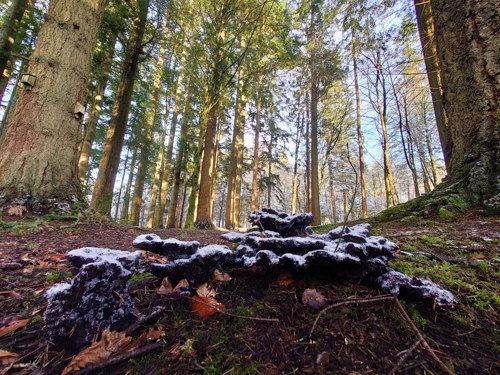
Short Walks in Arrochar & Tarbet
Arrochar to Robert's Bridge
Distance: 3.25km/2 miles | Time: 1¼ to 1½ hoursAscent: 115m
Terrain: Pavement, track and path. Generally easy but with a section of steeper ascent and a low underpass. Can be muddy and uneven in places.
Access: Not suitable for wheelchairs.
Map/s: OS Landranger 56 (1:50 000) OS Explorer 39 (1: 25 000)
Start: Three Villages Community Hall, Arrochar
Finish: Three Villages Community Hall, Arrochar
Parking: Three Villages Community Hall, Arrochar (please support with donations – further paid parking available at the north end of Arrochar)
Grid Reference: NN 296 040
Public Transport: Buses 302, 926, 976
Toilets: Temporary toilets at the north car park and public toilets at Tarbet Pier car park
Facilities: Arrochar has a number of shops and eateries including the Cù Mara Bistro and Takeaway next to the Community Hall, Ben Arthur’s Bothy, the Olive Branch takeaway, village stores, the Arrochar Chippy, several hotels and the Village Inn.
Getting there: By car, via the A83 from Glasgow or Inverary, the A82 and A83 from Crianlarich and the A814 from Helensburgh. *Arrochar and Tarbet train station is 1.75km away (a 30min walk via the pavement by the A83). Buses run from Glasgow, Helensburgh, Carrick Castle, Oban & Campbeltown.
Route Description
The village of Arrochar lies nestled at the head of Loch Long and has had a long and sometimes turbulent history. Of note is when Norse forces heaved dozens of their ships over the narrow isthmus from Arrochar to Tarbet* (Loch Lomond) in 1263. Their reason was to be able to make an attack on the Scots using inland waters having gone to battle with Alexander III of Scotland over ownership of the Western Isles. But why had they gone to battle, after all had they not been granted the Isles?
Indeed, in 1098, the Norse King Magnus Barefoot had originally been granted the Western Isles and Kintyre following the Treaty of Tarbert* (Loch Fyne) an agreement he had made with King Edgar of Scotland, allowing him control over any of the islands he could sail round – or, as it turned out, drag boats over (he gained Kintyre by hauling boats overland from West Loch Tarbert to East Loch Tarbert, another narrow isthmus).
But by the 13th Century Alexander III had hopes that he could buy the lands back and it seemed that Haakon IV, the Norse King of the time, was not happy with this and proceeded to battle instead, most probably exacerbated by Scottish attacks in the north. Eventually King Haakon IV was defeated, dying in Orkney, and the Treaty of Perth in 1266 saw the Western Isles and Kintyre returned to Scotland (Historic Environment Scotland, Tarbert Loch Fyne & Scotclans).
This walk from the Three Villages Community Hall is an excellent way to quickly access grand views down Loch long and over to the fabulous western peaks of the Arrochar Alps, including the iconic Cobbler (Ben Arthur) with its rugged and spectacular outline.
From the hall car park turn left down the road and follow the pavement until opposite Arrochar Parish Church. Built in 1847 this superseded an older church dating back to 1733 and offers a fine vantage point over Loch Long. An in-depth history of the church is documented in an interesting article by the Rev. Ian D. Reid, dating back to at least 1959, which can be found on the church website (Arrochar Parish Church). The lands here had been under rule of the MacFarlane Clan since the 14th century, a clan renowned for both their cattle rustling and support of Robert the Bruce. Unfortunately large debts after the passing of their 20th chief in 1767 saw their lands being sold off and many of the clan members moved elsewhere or went on to America (Trossachs).
Cross the road with care to the lane up the south side of the church, if you wish to enter the grounds there is a small gate on your left, you can then exit from the back of the church back onto the lane, which is effectively a crescent.
From the lane at the back/east end of the church you will see a small path with a sign post leading up between some houses and the playing fields. Take this and the path takes a long upward zigzag leading you all the way to the main Three Lochs route on the other side of the railway, above. The railway underpass is low so watch your head!
On reaching the main track turn right. It is now just a short stroll down to Robert’s bridge, with its small waterfall, best seen after heavy rain. En route to your left you will see the stone viewpoint with its curved seat, which is the best spot to go and enjoy the view from. Looking down over Loch Long one can only but wonder at the oncoming Long Boats all those centuries ago. The hills here would have been much more heavily wooded and the route through the glen would have been difficult to drag through so many boats. Across the loch the stunning peaks of the Arrochar Alps stand proudly, the haunt of many a hiker and climber and immensely popular with those coming from Glasgow from the 19th Century onwards due to their accessibility by train.
To return walk back down your outward path to Arrochar and maybe find yourself a treat at one of the local eateries whilst still enjoying the view.
*Tarbert and Tarbet are anglicised forms of the Gaelic word Tairbeart, meaning isthmus, a narrow piece of land between two bodies of water, often the sea but sometimes like Tarbet, between fresh and saltwater lochs. There are quite a few Tarberts in Scotland and just to add to the spelling variations the hill at the back of Tarbet is named on OS maps as Cruach Tairbeirt meaning the conical hill of the isthmus.
The described route and accompanying information are there to be used as a guide. Please be aware that track and path closures can happen at any time. All walks are undertaken at your own risk.
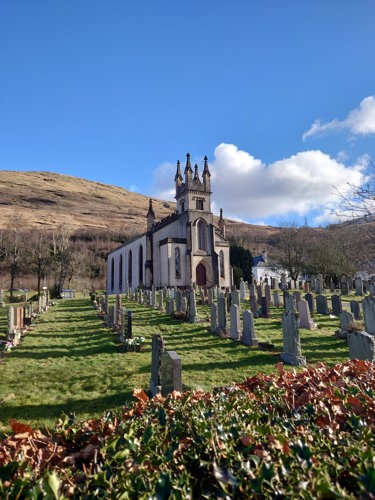
Mini Circular from Arrochar
Distance: 1.7km/1 mile | Time: ½ to 1 hourAscent: 70m
Terrain: Pavement, road and path, steep and uneven in places. Some patches of undergrowth on the upwards path.
Access: Not suitable for wheelchairs or buggies. Road crossings in 30mph zone, care should be taken as there are no formal pedestrian crossing points.
Map/s: OS Landranger 56 (1:50 000) OS Explorer 39 (1: 25 000)
Start: Three Villages Community Hall, Arrochar
Finish: Three Villages Community Hall, Arrochar
Parking: Three Villages Community Hall, Arrochar (please support with donations – further paid parking available at the north end of Arrochar)
Grid Reference: NN 296 040
Public Transport: Buses 302, 926, 976. Trains from Glasgow, Oban and Mallaig*
Toilets: Temporary toilets at the north car park and public toilets at Tarbet Pier car park
Facilities: Arrochar has a number of shops and eateries including the Cù Mara Bistro and Takeaway next to the Community Hall, Ben Arthur’s Bothy, the Olive Branch takeaway, village stores, the Arrochar Chippy, several hotels and the Village Inn.
Getting there: By car, via the A83 from Glasgow or Inverary, the A82 and A83 from Crianlarich and the A814 from Helensburgh. *Arrochar and Tarbet train station is 1.75km away (a 30min walk via the pavement by the A83). Buses run from Glasgow, Helensburgh, Carrick Castle, Oban & Campbeltown.
Route Description
The village of Arrochar lies nestled at the head of Loch Long and has had a long and sometimes turbulent history. Of note is when Norse forces heaved dozens of their ships over the narrow isthmus from Arrochar to Tarbet* (Loch Lomond) in 1263. Their reason was to be able to make an attack on the Scots using inland waters having gone to battle with Alexander III of Scotland over ownership of the Western Isles. But why had they gone to battle, after all had they not been granted the Isles?
Indeed, in 1098, the Norse King Magnus Barefoot had originally been granted the Western Isles and Kintyre following the Treaty of Tarbert* (Loch Fyne) an agreement he had made with King Edgar of Scotland, allowing him control over any of the islands he could sail round – or, as it turned out, drag boats over (he gained Kintyre by hauling boats overland from West Loch Tarbert to East Loch Tarbert, another narrow isthmus). But by the 13th Century Alexander III had hopes that he could buy the lands back and it seemed that Haakon IV, the Norse King of the time, was not happy with this and proceeded to battle instead, most probably exacerbated by Scottish attacks in the north. Eventually King Haakon IV was defeated, dying in Orkney, and the Treaty of Perth in 1266 saw the Western Isles and Kintyre returned to Scotland (Historic Environment Scotland, Tarbert Loch Fyne & Scotclans).
This short circular walk gives you the opportunity to gain some height to overlook the village from the woodland on the southwestern flanks of the hill Cruach Tairbeirt. A bench at the top of the walk allows you to rest awhile and the glimpses through the trees allow for long reaching views down Loch Long and over to the iconic outline of the Cobbler (Ben Arthur).
Turn right out of the hall car park, crossing the road to follow the pavement by the seawall for a short distance. There are some fantastic views over to the Arrochar Alps here, the old pier offering plenty of photo opportunities.
The pier was in regular use as far back as the early 1800s, from the old wooden paddle steamers of the Loch Goil Company to the much later and familiar paddle steamer that still plies British seas today, the ‘Waverley’, the last sea going paddle steamer in the world, launched in 1946. Back in the 19th and early 20th centuries excursions and cruises were incredibly popular and an efficient means to get around compared to the slow rigours of travelling via the Old Military Road built in 1743 (the current main road, the A83, was not constructed until the 1930s). And with popularity came a fair bit of competition with grander and more comfortable steamers built to attract their custom including the two-funnel steamer the ‘Chancellor’, built in 1853, which was replaced with two more ‘Chancellors’ with ever more mod cons. And for those interested in rare breeds of dog there was even a boat called the ‘Dandie Dinmont’ (built 1895). In 1892 there were three steamers a day, by 1968 three a week, and now the sad remains of the pier are but a reminder of grand days out on the waters of Loch Long. For those interested in the boats that plied these waters it is worth looking on Arrochar’s Heritage site.
Across the water you will also see the remains of another pier/jetty. Built in 1915 this had a very different use as a Torpedo Testing Station. The loch was used to fire and test unarmed torpedoes manufactured in Greenock and the range was used right up until 1986 (Canmore ID 135114). It has only fallen into complete disrepair in the last couple of decades and has become a popular spot for divers.
Opposite the pier you will see a right turn up the south side of the hotel. Cross back over the road to take this, it narrows down into a path and then goes up some steps leading you to the main road above. Taking great care cross the road over to the small lane opposite just right of a lamp post. The small lane leads you up past Ravenswood, a couple of houses and then onto a path where the road ends. It soon leaves the houses behind, climbing up into the woodland. Generally, the path is in good condition, but a couple of spots have become more overgrown with lack of use, and it can be a little muddy in places. After veering right over a small burn at the back of the houses it climbs quicky to meet the main track above. Here a bench offers respite and time to start enjoying the views.
Your route is now down the path to the left, this will lead you into the centre of Arrochar via a long zigzag. Take the time to enjoy the views down Loch Long where there are breaks in the woodland, before dropping down to the steps leading you back to the main road. Cross the road with care, your return route is left although you may decide to head round to the head of the Loch first (right). There are several eateries en route, so there is no shortage of refreshment before you head back to the hall. Remember to bear right along the seafront (via the Helensburgh road) to get back to the car park.
The described route and accompanying information are there to be used as a guide. Please be aware that track and path closures can happen at any time. All walks are undertaken at your own risk.
Tarbet to Loch Long Viewpoint
Distance: Up to 6.2km/4 miles | Time: 2 to 3 hoursAscent: 130m
Terrain: Paved, or wide gravel/dirt tracks, can be muddy in places. Some uphill sections but generally fairly level once on main route through the glen.
Access: Assisted all terrain wheelchairs and buggies, the closest access down to the main road is at the Tarbet end.
Map/s: OS Landranger 56 (1:50 000) OS Explorer 39 (1: 25 000)
Start: Tarbet Pier car park (or bus stop by hotel or railway station)
Finish: Tarbet Pier car park (or bus stop by hotel or railway station)
Parking: Tarbet Pier car park
Grid Reference: NN 319 044
Public Transport: Buses 302, 914, 916, 926, 975, 976
Trains from Glasgow, Oban and Mallaig
Ferry across Loch Lomond
Toilets: Yes
Facilities: There are several places for refreshment including the café in the car park itself, the Tarbet Hotel, The Slanj, Tarbet Village Shop and in Arrochar.
Getting there: By car, via the A83 from Glasgow or Inverary, the A82 from Crianlarich and the A814 from Helensburgh. By rail to Arrochar and Tarbet train station (this station has steps). Regular buses from Glasgow, Helensburgh, Carrick Castle, Oban, Campbeltown and via Crianlarich.
Route Description
Visiting Loch Lomond and taking a boat trip from Tarbet or driving over to Arrochar and Succoth to climb the heady heights of The Cobbler (Ben Arthur), Beinn Narnain or Beinn Ime may be familiar to many, as are the journeys that take you north to Crianlarich, west to Inveraray or up Loch Lomond’s eastern shores to climb Conic Hill or Ben Lomond.
But you can also gain some cracking views both over Loch Long and across to Ben Lomond by taking in part of the Three Lochs Way by walking across the isthmus between Tarbet and Arrochar (Tarbet means isthmus, a narrow neck of land). This walk (marked in white) can be undertaken from Tarbet Pier car park or the railway station and can also be included as part of the longer Hidden Heritage Trail (marked in red on our map). The former is the better option for those that wish for easy wide tracks without any steep narrow sections, although there is a little ascent out of the valley initially. It also means you can turn back as soon as you wish if you don’t want to go the full distance. For ease we have given directions from Tarbet Pier car park but you can also start form the hotel or railway station.
Leaving the car park cross over to the Tarbet Hotel. Continue past the hotel up to the main road junction and turn right towards Arrochar. After the road turns sharply left, continue along the pavement for nearly 300m, until you reach the first lane turning on the left across the road. This is clearly signposted for the Three Lochs Way as well as the Hidden Heritage Trail. Do take care crossing. Passing through the gate follow the easy wide track slightly up hill before bearing right. There are good views over to Ben Lomond. The track now keeps fairly level for the next couple of kilometres with lovely views to the hills either side and beyond to the Arrochar Alps and The Cobbler. Note the old sheep fanks about halfway along on your right.
What is perhaps of the most interest is that the valley below you was once the scene of longboats and Vikings – not on water either! In 1263 Norse and Scottish forces went into battle over the ownership and rights of the Western Isles. Below you the Norse forces heaved dozens of their ships from Arrochar on the one side, to Tarbet on Loch Lomond on the other. Why? To attack from inland waters because the Scots had upset the Norse King Haakon IV. Essentially, they were battling over old rights. The Norse King Magnus Barefoot had originally been granted the Western Isles and Kintyre in 1098, following an agreement that he could control what he could sail round – or, as it turned out, drag boats over/round (he gained Kintyre by hauling boats from West Loch Tarbert to East Loch Tarbert, another narrow isthmus). But by the 13th Century Alexander III of Scotland had hopes that he could buy the lands back, but it seemed that Haakon IV, the Norse King of the time, was not happy with this and proceeded to battle instead, possibly exacerbated by Scottish attacks in the north. Eventually Haakon was defeated, dying in Orkney, and the Treaty of Perth in 1266 saw the Western Isles and Kintyre returned to Scotland (Historic Environment Scotland, Tarbert Loch Fyne & Scotclans).
As you approach the west the views open out over Loch Long and over to the superbly shaped mountain, The Cobbler (Ben Arthur). Popular with climbers and walkers from the 19th Century, due to easy access from Glasgow by boat or train, the iconic skyline has captured the imagination of many an artist and photographer too.
Soon you will pass a turning right down to Arrochar (where you will wish to go if undertaking the full Hidden Heritage Trail loop) which is signposted. However, for this route continue for another 300m to the lovely viewpoint and a stone seat where it is easy to sit awhile and imagine those marauding Viking ships below.
In more recent centuries, namely from the 1800s on, the sea loch below would have been busy with wooden paddle steamers taking holidaymakers and day trippers on excursions up and down the loch from Rothesay, Helensburgh, Dumbarton and even Glasgow. Sadly, the pier is now in complete disrepair but the Waverley, the last sea going paddle steamer in the world, would have once visited here after numerous others steamers that have come and gone. There used to be three sailings a day!
If you wish to go as far as Robert’s Bridge it is a just 200m further on, good for a day when there has been enough rain to fill the small falls. To return follow your outward route unless doing the full loop.
The described route and accompanying information are there to be used as a guide. Please be aware that track and path closures can happen at any time. All walks are undertaken at your own risk.
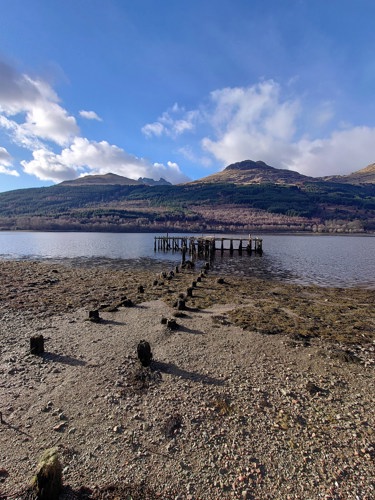
Cruach Tairbeirt (Hill Walk)
Distance: 4.9km/3 miles | Time: 2 to 2½ hoursAscent: 385m
Terrain: Mixture of forestry track, narrow steep path and open hillside. Suited to those confident in their navigation and hill skills.
Access: Suitable for hillwalkers. No wheelechair or buggie access.
Map/s: OS Landranger 56 (1:50 000) OS Explorer 39 (1: 25 000)
Start: Arrochar and Tarbet Railway Station
Finish: Arrochar and Tarbet Railway Station
Parking: Occasional street parking nearby or at Tarbert Pier 1km away.
Grid Reference: NN 319 044
Public Transport: Buses 302, 914, 916, 926, 975, 976
Trains from Glasgow, Oban and Mallaig
Ferry across Loch Lomond (Tarbet)
Toilets: At Tarbert Pier car park
Facilities: There are several places for refreshment including the Tarbet Hotel, The Slanj, Tarbet Village Shop and at the café in Tarbert Pier car park
Getting there: By car, via the A83 from Glasgow or Inverary, the A82 from Crianlarich and the A814 from Helensburgh. By rail to Arrochar and Tarbet train station (this station has steps). Regular buses from Glasgow, Helensburgh, Carrick Castle, Oban, Campbeltown and via Crianlarich.
Route Description
Hidden just at the back of Tarbet a wee hill, Cruach Tairbeirt, stands in a position which affords some of the best views of Ben Lomond, The Cobbler, the northern Arrochar Alps and many more beyond. An Argyll Marilyn at 415m (a hill with a 150m drop all round), its moorland top allows for an impressive 360 panorama. Cruach Tairbeirt means conical hill of the isthmus, reflecting the narrow stretch of land between Loch Lomond and Loch Long.
For those wishing to enjoy a hillwalk and the stunning views Cruach Tairbeirt has to offer this can be undertaken directly from the railway station, handy if coming by train. Going through the underpass from the on-road station parking you will need to take a left turn (for now, the other path is closed) and follow the path until you meet the main forestry road and turn right.
Follow the forestry road for 500m until you reach a path that will take you directly up the hill on your left (opposite the other end of the closed path). Be aware there may be forestry traffic as harvesting is currently underway. The path heads steeply upwards for 100m, initially through felled woodland, before crossing a small burn then directly up into the plantation. Keep the burn on the left for 200m, in line with the stances of trees. You may spot the small stone cairns between the trees but if not keep a close look out for the path veering to the right and the fallen trees that have been partially felled to keep the path accessible.
The right turn will take you out onto the open hillside, the path becoming increasingly evident as you leave the trees behind. It is now just over 1 kilometre to the summit, with the path meandering ever upwards, sometimes quite steeply. Do tread softly where possible to avoid further erosion of the peat on those steeper bits. The summit trig point views are quite a treat, and it is worth spending time wandering across the flattish top to get spectacular views up and down Loch Lomond.
Return down your ascent path until you once more meet the forestry road. Follow the forestry road for 500m until you come to your turning left back to the railway station.
The Slanj or village shop are handily just at the bottom of the hill (bearing left) should a treat be on the cards.
The described route and accompanying information are there to be used as a guide and do not replace the use of map and compass and the skills required to use them. Please be aware that track and path closures can happen at any time, particularly where there are forestry operations. All walks are undertaken at your own risk.
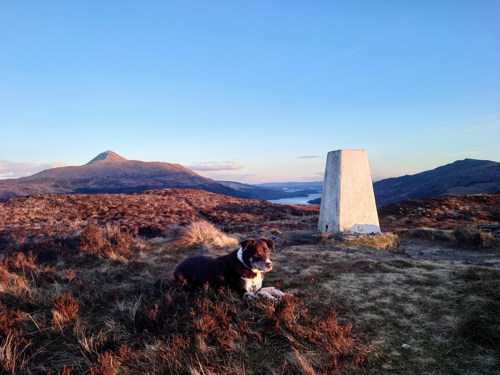
Short Walks in Tarbert & Loch Fyne
Tarbert Castle and Viewpoint
Distance: 3.3km/2 miles | Time: 1 to 1½ hours (walking time)Ascent: 120m
Terrain: Paved road, steps, grassy paths, steep in places
Access: Not suitable for wheelchairs or buggies unless accessed via Bruce Hill (at Grid ref: NR 866 686) – limited access
Map/s: OS Landranger 62 (1:50 000) OS Explorer 357 (1:25 000)
Start: Village car park
Finish: Village car park
Parking: Village car park
Grid Reference: NR 862 685
Public Transport: Bus 447, 448, 449, 926 and ferry to/from Portavadie
Toilets: Harbour Street
Facilities: There are several places to eat and drink including Café Ca’Dora, Lulabelles of Tarbert, The Gather, The Starfish, The Anchorage Bistro, The Anchor, The Islay Frigate Hotel, The Marine Bistro and The Corner House. There are also several good local food shops and galleries and there is a wide range of accommodation in the area from camping pods to bespoke hotels.
Getting there: Tarbert is situated on the A83 south of Lochgilphead and north of Campbeltown at the north end of Kintyre. It is a 2½ hour drive from Glasgow.
Route Description:
The walk starts from the small village car park opposite Tarbert Parish Church, which stands proudly over the village’s western aspect. Many a coin has been thrown down its banks to children by newlyweds and the building is a fine example of Georgian architecture.
Turning left out of the car park in front of the church follow the road down to the seafront and, after carefully crossing the road near the small Co-op, continue along the harbourfront towards the main pier. Once, the harbour - redeveloped by the engineer Thomas Telford in the 19th Century - was filled with fishing boats jostling for space at a time when herring was plentiful, the pier a hive of activity with wooden fish boxes piled high as the catch of the day was sold on. En route, you will pass the Earra Gael craft shop. Once the weighbridge office it was converted into a cooperative craft shop half a century ago, allowing local artists, craftspeople, and producers to display and sell their wares. The initial agreement with the harbour board meant that the staff on duty would have to record the lorries using the weighbridge so that the correct dues could be collected. It continues to sell many local arts and crafts to this day.
Continue until you reach the pier and cross over to the Loch Fyne Gallery. Once a Ship’s Chandlers the property featured in John MacDougall Hay’s book, Gillespie, published in 1914 which gained a resurgence of popularity in the late 20th Century. It was then taken over as a grocery before lying empty for many years. It was converted from its state of disrepair into the Ann R. Thomas Gallery in 1975 and once included a print and packing room for offset lithography, now part of the rear display space. Just beyond the gallery and dentist you will see steps up to your right signposted to the castle and Kintyre Way, take these.
After a short but steep climb, you reach the remains of Tarbert Castle. The castle was most probably built on the site of an old fort. In 1325 Robert the Bruce undertook major works to fortify and enlarge the castle in order to protect his territory from the Lord of the Isles who was, at that time, allied with England. There are clear accounts for the work undertaken submitted by the Constable for Tarbert, John de Lany, in 1326; the records are some of the oldest on the Scottish Exchequer Rolls in existence. However, it was not until the late 15th Century that James IV added the Tower House, the remains of which give the castle its main outline today. Below the Tower House are the remains of a dungeon, a reminder of tougher times for miscreants.
After exploring the castle, the path continues up the hill past the community orchard and onto the open hillside. Here there used to be many cattle and sheep but although you may come across sheep at the castle there have not been livestock on the hill since the first forestry plantations some 40 years ago (much of the land this walk encompasses is owned and managed by Forestry Land Scotland). There are, however, deer - who will happily munch on all manner of plants and young trees - and occasionally rare adders or slow worms might be spotted sunbathing.
Ignoring a path off to your left crossing an old meadow (leading to the houses at the top of The Big Brae) keep right at the next fork. The path will continue past a turning to the right (leading straight up the hill) and follows a burn (stream) which you will eventually cross. Going uphill slightly you will reach a small path on your right leading to the old well (spring). The main path continues to a fork, turn right then almost immediately left to gain the viewpoint with its excellent panorama over Loch Fyne.
On leaving the viewpoint turn right to re-join the path and this time take the right-hand fork to continue the circuit. The path will drop you down to cross the burn again before re-joining your outward route back into Tarbert.
The described route and accompanying information are there to be used as a guide. Please be aware that track and path closures can happen at any time. All walks are undertaken at your own risk.
Tarbert Castle (Hill Walk)
Distance: 5.75km/3½ miles | Time: 1½ to 2 hours (allow extra time for exploration)Ascent: 240m
Terrain: Paved road, steps, grassy paths, steep in places
Access: Not suitable for wheelchairs or buggies
Map/s: OS Landranger 62 (1:50 000) OS Explorer 357 (1:25 000)
Start: Village car park
Finish: Village car park
Parking: Village car park
Grid Reference: NR 862 685
Public Transport: Bus 447, 448, 449, 926 and ferry to/from Portavadie
Toilets: Harbour Street
Facilities: There are several places to eat and drink including Café Ca’Dora, Lulabelles of Tarbert, The Gather, The Starfish, The Anchorage Bistro, The Anchor, The Islay Frigate Hotel, The Marine Bistro and The Corner House. There are also several good local food shops and galleries and there is a wide range of accommodation in the area from camping pods to bespoke hotels.
Getting there: Tarbert is situated on the A83 south of Lochgilphead and north of Campbeltown at the north end of Kintyre. It is a 2½ hour drive from Glasgow.
Route Description:
The walk starts from the small village car park opposite Tarbert Parish Church, which stands proudly over the village’s western aspect. Many a coin has been thrown down its banks to children by newlyweds and the building is a fine example of Georgian architecture.
Turning left out of the car park in front of the church follow the road down to the seafront and, after carefully crossing the road near the small Co-op, continue along the harbourfront towards the main pier. Once, the harbour - redeveloped by the engineer Thomas Telford in the 19th Century - was filled with fishing boats jostling for space at a time when herring was plentiful, the pier a hive of activity with wooden fish boxes piled high as the catch of the day was sold on. En route, you will pass the Earra Gael craft shop. Once the weighbridge office it was converted into a cooperative craft shop half a century ago, allowing local artists, craftspeople, and producers to display and sell their wares. The initial agreement with the harbour board meant that the staff on duty would have to record the lorries using the weighbridge so that the correct dues could be collected. It continues to sell many local arts and crafts to this day.
Continue until you reach the pier and cross over to the Loch Fyne Gallery. Once a Ship’s Chandlers the property featured in John MacDougall Hay’s book, Gillespie, published in 1914 which gained a resurgence of popularity in the late 20th Century. It was then taken over as a grocery before lying empty for many years. It was converted from its state of disrepair into the Ann R. Thomas Gallery in 1975 and once included a print and packing room for offset lithography, now part of the rear display space. Just beyond the gallery and dentist you will see steps up to your right signposted to the castle and Kintyre Way, take these.
After a short but steep climb, you reach the remains of Tarbert Castle. The castle was most probably built on the site of an old fort. In 1325 Robert the Bruce undertook major works to fortify and enlarge the castle in order to protect his territory from the Lord of the Isles who was, at that time, allied with England. There are clear accounts for the work undertaken submitted by the Constable for Tarbert, John de Lany, in 1326; the records are some of the oldest on the Scottish Exchequer Rolls in existence. However, it was not until the late 15th Century that James IV added the Tower House, the remains of which give the castle its main outline today. Below the Tower House are the remains of a dungeon, a reminder of tougher times for miscreants.
After exploring the castle leave the castle grounds through the south gate to join the Kintyre Way, which passes the community orchard on your right. Soon after you go over a small rise, ignore a path to your left leading to houses at the top of the Big Brae. Just beyond is a Y junction; take the right-hand fork leaving the Kintyre Way.
You will now be following a well-kept route, which was once merely a faint heathery sheep track with little sign of bracken, rarely trodden. Keep an eye out for adders, they do live here and enjoy sunbathing on sunnier days but are very shy. After 150m turn right. The path will now climb steeply on the right-hand side of a burn (stream). After 250m there is the first viewpoint to your left. The second is just 100m further on your right and has a wider view over the village. Both are worth taking the time for.
Directly after the junction leading to the second viewpoint bear left over a bridge and up the hill. The path meanders and goes up steeply before reaching a final rise and dropping down to the main forestry track from Corranbuie. This section of path can be a mass of orchids in early summer. There are also occasional gluts of bilberries which make for a welcome sweet refreshment en route.
Turn left on to the forestry track and continue for 350m where you will reach a path on your left which will take you back down to Tarbert on part of the Kintyre Way. The route passes a huge millennium cairn and another viewpoint just off to the right. The views up Loch Fyne towards Ben Cruachan are superb, especially on a clear day.
There are steeper sections, particularly towards the bottom of the hill, and there are also a couple of viewpoints. The one after the big zig-zag down the hill is off to your right. On leaving this you can either take the left or right-hand fork as both lead you back to your outward route. I suggest going right to complete a circuit BUT if you want to visit the old well (spring) you will see another tiny path left just after taking the left fork. If you keep right at the fork after the viewpoint the path will drop you down to cross the burn you followed uphill earlier before re-joining your outward route back into Tarbert.
Note: Just be aware that there may be forestry operations as many of the trees have reached maturity so there have been a number of logging wagons and felling machinery in action.
The described route and accompanying information are there to be used as a guide. Please be aware that track and path closures can happen at any time. All walks are undertaken at your own risk.
Extended Hill and Coastal Walk (Mealdarroch Circular)
Distance: 8km/5 miles | Time: 2½ to 3 hours (allow extra time for exploration)Ascent: 280m
Terrain: Paved road, steps, grassy paths, forest track, steep in places
Access: Not suitable for wheelchairs or buggies
Map/s: OS Landranger 62 (1:50 000) OS Explorer 357 (1:25 000)
Start: Village car park
Finish: Village car park
Parking: Village car park
Grid Reference: NR 862 685
Public Transport: Bus 447, 448, 449, 926 and ferry to/from Portavadie
Toilets: Harbour Street
Facilities: There are several places to eat and drink including Café Ca’Dora, Lulabelles of Tarbert, The Gather, The Starfish, The Anchorage Bistro, The Anchor, The Islay Frigate Hotel, The Marine Bistro and The Corner House. There are also several good local food shops and galleries and there is a wide range of accommodation in the area from camping pods to bespoke hotels.
Getting there: Tarbert is situated on the A83 south of Lochgilphead and north of Campbeltown at the north end of Kintyre. It is a 2½ hour drive from Glasgow.
Route Description:
This variation of the better-known Tarbert Hill walk allows for a slightly extended exploration of Tarbert’s eastern reaches with the chance to visit a waterfall and the shell beaches that were formed in an era when huge numbers of queenie shells were deposited off the old pier end. It encompasses history, fabulous views up Loch Fyne and a chance to enjoy the natural anchorage and bustling fishing village of Tarbert.
The walk starts from the small village car park opposite Tarbert Parish Church, which stands proudly over the village’s western aspect. Many a coin has been thrown down its banks to children by newlyweds and the building is a fine example of Georgian architecture.
Turning left out of the car park in front of the church follow the road down to the seafront and, after carefully crossing the road near the small Co-op, continue along the harbourfront towards the main pier. Once, the harbour - redeveloped by the engineer Thomas Telford in the 19th Century - was filled with fishing boats jostling for space at a time when herring was plentiful, the pier a hive of activity with wooden fish boxes piled high as the catch of the day was sold on. En route, you will pass the Earra Gael craft shop. Once the weighbridge office it was converted into a cooperative craft shop half a century ago, allowing local artists, craftspeople, and producers to display and sell their wares. The initial agreement with the harbour board meant that the staff on duty would have to record the lorries using the weighbridge so that the correct dues could be collected. It continues to sell many local arts and crafts to this day.
Continue until you reach the pier and cross over to the Loch Fyne Gallery. Once a Ship’s Chandlers the property featured in John MacDougall Hay’s book, Gillespie, published in 1914 which gained a resurgence of popularity in the late 20th Century. It was then taken over as a grocery before lying empty for many years. It was converted from its state of disrepair into the Ann R. Thomas Gallery in 1975 and once included a print and packing room for offset lithography, now part of the rear display space. Just beyond the gallery and dentist you will see steps up to your right signposted to the castle and Kintyre Way, take these.
After a short but steep climb, you reach the remains of Tarbert Castle. The castle was most probably built on the site of an old fort. In 1325 Robert the Bruce undertook major works to fortify and enlarge the castle in order to protect his territory from the Lord of the Isles who was, at that time, allied with England. There are clear accounts for the work undertaken submitted by the Constable for Tarbert, John de Lany, in 1326; the records are some of the oldest on the Scottish Exchequer Rolls in existence. However, it was not until the late 15th Century that James IV added the Tower House, the remains of which give the castle its main outline today. Below the Tower House are the remains of a dungeon, a reminder of tougher times for miscreants.
After exploring the castle leave the castle grounds through the south gate to join the Kintyre Way, which passes the community orchard on your right. Soon after you go over a small rise, ignore a path to your left leading to houses at the top of the Big Brae. Just beyond is a Y junction; take the right-hand fork leaving the Kintyre Way.
You will now be following a well-kept route, which was once merely a faint heathery sheep track with little sign of bracken, rarely trodden. Keep an eye out for adders, they do live here and enjoy sunbathing on sunnier days but are very shy. After 150m turn right. The path will now climb steeply on the right-hand side of a burn (stream). After 250m there is the first viewpoint to your left. The second is just 100m further on your right and has a wider view over the village. Both are worth taking the time for.
Directly after the junction leading to the second viewpoint bear left over a bridge and up the hill. The path meanders and goes up steeply before reaching a final rise and dropping down to the main forestry track from Corranbuie. This section of path can be a mass of orchids in early summer. There are also occasional gluts of bilberries which make for a welcome sweet refreshment en route.
Turn left on to the forestry track and continue for 1km, ignoring the first path on your left (the Kintyre Way leading back to Tarbert). The track crosses a large burn, passes a turning area on your left and drops gently down. Just before going round a right-hand bend look out for a small cairn on your left after crossing a second smaller burn. Turn left onto the path by the cairn. If you start to go back uphill, you have gone too far!
The path meanders downhill before crossing the small burn followed by the large burn crossed earlier. It is easy enough to manage unless in spate when it can usually be negotiated slightly upstream. If you wish to explore there are some fabulous waterfalls to your left, more easily reached once the bracken has died down in winter but there is a small path leading to them. The main grassy path is pleasant walking and often dragonflies can be seen here throughout summer. Views over Loch Fyne have been opened out after recent felling. On reaching a well-preserved sheep fank – a reminder of pre-forestry days - the path leads uphill. Look out for the giant’s seat on your right!
Over the brow of the hill, you will see where the path joins a stony track ahead that takes you on but look out for well-beaten bracken on your right indicating a series of small paths kept open by Tarbert residents and seeded with wildflowers. These lead out to gain an excellent view over Loch Fyne, worth a small detour. Return to the path or track and head downhill. At a T-junction, you should turn left, and the steep tarmac road leads you down to the sea.
Turn right and head to the end of the road and an old jetty. A small path on your right leads you to the shell beaches, a reminder that thousands and thousands of scallop and queenie shells were once deposited here. Returning to the road it is now a nice easy 2km amble back into Tarbert via the old pier (which the Waverley occasionally visits), ferry terminal and yacht club.
The described route and accompanying information are there to be used as a guide. Please be aware that track and path closures can happen at any time. All walks are undertaken at your own risk.
White Shore Walks from Garval
Distance: 1.5 to 2.8km/1 to 1¾ miles | Time: 30 mins to 1½ hoursAscent: 55m to 130m
Terrain: Paved road, steps, gravel or grassy paths, steep in places
Access: Not suitable for wheelchairs or buggies
Map/s: OS Landranger 62 (1:50 000) OS Explorer 357 (1:25 000)
Start: Garval car park
Finish: Garval car park
Parking: Garval car park
Grid Reference: NR 868 692
Public Transport: Bus 447, 448, 449, 926 and ferry to/from Portavadie
Toilets: Harbour Street
Facilities: There are several places to eat and drink, including Café Ca’Dora, Lulabelles of Tarbert, The Gather, The Starfish, The Anchorage Bistro, The Anchor, The Islay Frigate Hotel, The Marine Bistro and The Corner House. There are also several good local food shops and galleries, and there is a wide range of accommodation in the area, from camping pods to bespoke hotels.
Getting there: Tarbert is situated on the A83 south of Lochgilphead and north of Campbeltown at the north end of Kintyre. It is a 2½ hour drive from Glasgow.
Route Description:
All walks to White Shore, the Bird Hide and Cnoc Mòr can be reached from the small car park at the end of Garval Terrace. If on foot this is easily reached by following the path towards the marina and then joining the small harbourside road after the fire station and following it to its end.
Tarbert harbour front and Pier Road are accessible for wheelchair users and buggies.
White Shore:
The walk over to White Shore has long been popular with locals and visitors alike. On sunny days when the tide is low, the sands are easier to reach if thinking of having a swim or in bad weather it can be a cathartic place just to watch the waves come crashing in. This route is easy to moderate (there are a couple of steeper stepped sections).
Following a recently improved path and new walkway over a boggier section, the path passes through open hazel and birch woodland, the floor a rich carpet of mosses, lichens and bilberry. There are some lovely views across Dubh-chaol Linne at the northern end of Tarbert Harbour before the path meanders over the small promontory to White Shore.
Just be aware, it can get quite muddy just as your drop-down to White Shore especially after heavy rain, so wellies can be handy!
Cnoc Mòr:
Fewer folk climb up to the little viewpoint on the top of Cnoc Mòr, it is a very steep path and not suited to everyone! But if you want a different view over Tarbert and up and down Loch Fyne it is a good spot. There is an engraved metal plate pointing out what you can see but it is getting hard to read after many years of weathering.
To reach it, bear left off the main path after the new walkway, then follow the small network of paths, initially north, then veering right up through the trees (opposite a gate). After a short distance through birch and passing the odd fallen tree, the (very) steep ascent path up Cnoc Mòr is to your left. You will pass a couple of pine trees further up and need to keep heading up through the heather and bracken to your right until you reach the highest rock. Return down the same way (there are variations, but this is the most obvious). At the bottom of the hill, a path takes you pretty much straight ahead to meet the main path again, where you will turn left to drop to White Shore. Return along the main path back to Garval and Tarbert village.
It can get quite muddy, and the bracken can get quite high in midsummer (although you can usually still see a path through it).
The Bird Hide:
For those undertaking the White Shore walk or any combination of the small paths through the woodlands on the north side of Tarbert Harbour, this path takes you down to the spot which has been used as a bird hide but also affords a superb view over Tarbert Harbour at sunset. It can easily be added on to a walk to White Shore, but bear in mind it can get very boggy and there is the odd fallen tree! Generally easy, although there are some steps and obstacles because of the trees and the bog. To access, just take the small path right after the new boardwalk as you head towards White Shore (although you may prefer to visit on the way back, in which case it will be on your left!). Return to Garval along the main path.
The described route and accompanying information are there to be used as a guide. Please be aware that track and path closures can happen at any time. All walks are undertaken at your own risk.
